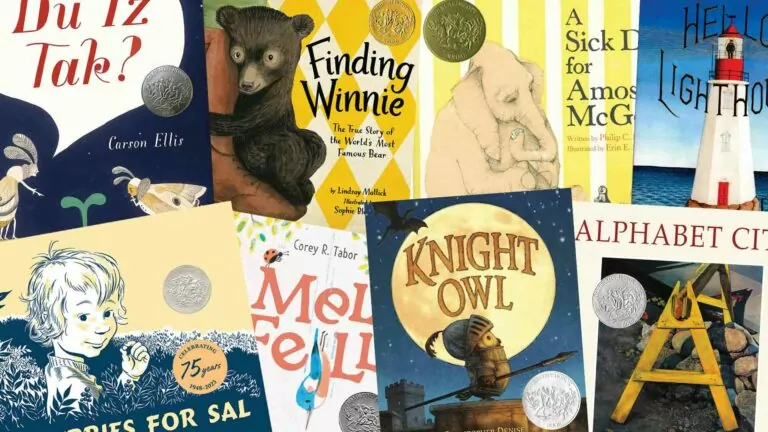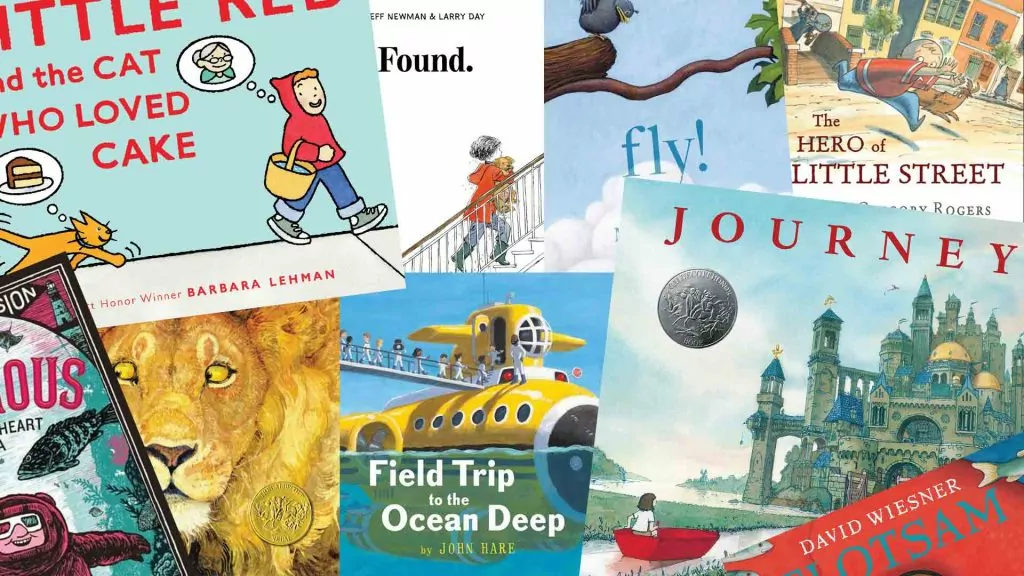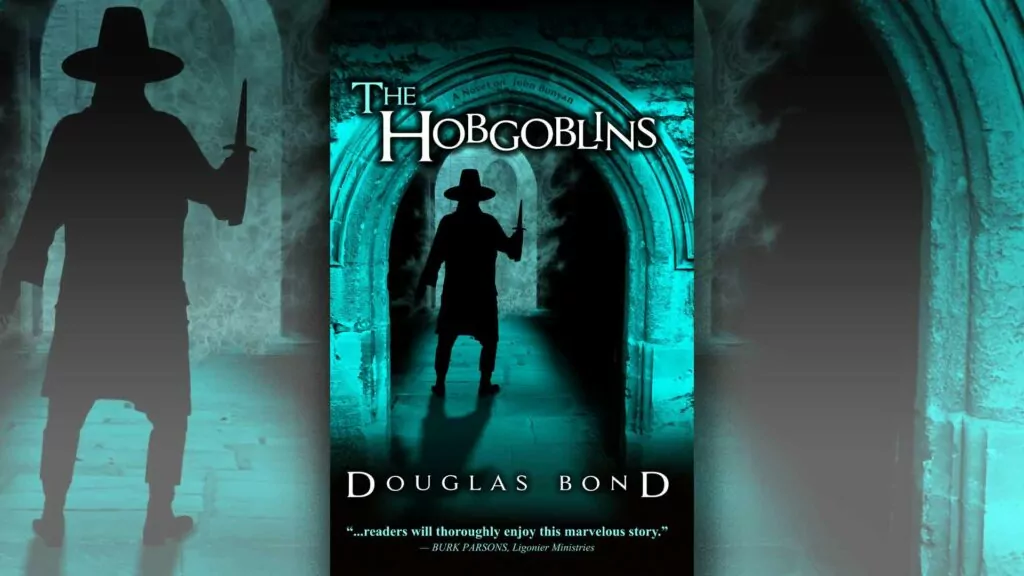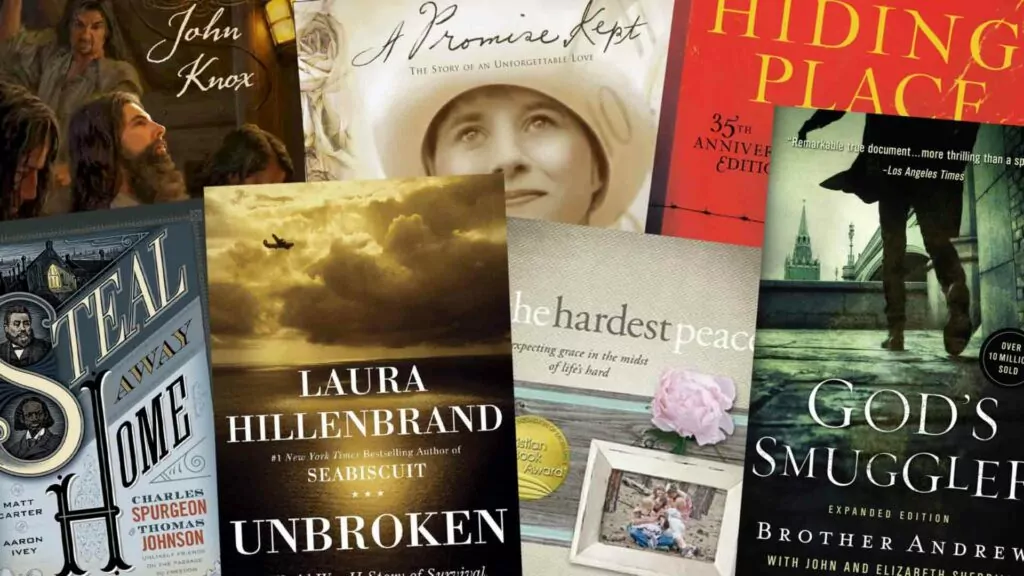As a new parent, I sometimes had a hard time finding picture books to read to my girls. There were just so many stunningly boring books out there (Amelia Bedelia, I’m talking about you!) and while my kids might have enjoyed many of them, I started going a little balmy when they asked me to read the same one again and again.
I also started noticing the devil had a foothold even in our public library’s picture book section. Most often the offending books simply celebrated brats, but a daughter who loves to dance got me to check out a book with a ballerina on the cover that I only realized afterwards was titled Princess Boy. It was about a boy who wanted to be a girl. That wasn’t the age I wanted to have to explain transgenderism to my little girl, but, well… now I had to.
That’s why I wanted to create a list for parents that they could use to reserve great picture books from their local library. The overall goal was to provide so many recommendations that a parent wouldn’t have to repetitively read any of them – there would always be another book they could pull out of the collection they’d just checked out from the library. I’ve also been involved in the purchasing for our local Christian school’s library, and knew that a good long list could be helpful for librarians too.
What follows is based on the Caldecott Medal. This award has been given annually since 1938 to the previous year’s “most distinguished American picture book for children,” as determined by the American Library Association (ALA). The award is given to the artist, rather than the author, because the pictures are the focus, not the words. Each year the ALA has also highlighted anywhere from one to six runners-up or “Honorees,” which gave me more than 350 books to sift through.
While the ALA is not Christian, their award gave me a place to start – here were their best of the best, and most of them were, at the very least, artistically impressive. And because they are “Caldecotts” you are quite likely to find many of these at your local library – availability was an important factor too.
However, their idea of good could differ quite sharply from mine, and was sometimes diametrically opposed to what God declares good. A 2015 Honoree, This One Summer (the first graphic novel to be honored), is about a couple of girls “discovering their sexuality” and has all sorts of F-bombs. While that sort of agenda is a more recent thing, there is some wackiness amongst the older entries too: 1974 Medal Winner Duffy and the Demon is, as the title suggests, about a demon, and 1971 Honoree In the Night Kitchen features a boy, often shown from the front, floating around in his birthday suit. So, sifting needed to be done!
Now, because the Medal Winners are pretty famous, I’ve rated all of them, putting them in categories of “Recommended,” “Take It or Leave It,” or “Don’t Bother.” I figure the Medalists are popular enough that parents might appreciate a warning about the worst of them. I’ve also looked at all or nearly all of the Honorees, but in this case I’ve only noted the ones that were worth recommending. These aren’t nearly as popular, so it didn’t seem worth it to catalogue cautions for all of them.
The result is a list of 140+ Caldecott recommendations for you and your family to consider. I’ve sometimes noted, or linked to, other great offerings by a particular author, which takes this list to well past two hundred.
If you aren’t already familiar with your local library’s reservation system it’s worth getting acquainted with it. You can go online and check this list against what they have, and then click a button or two to get the librarian to set aside your picks for you to drop by and grab. Our family used to live in the library on Saturday afternoons, but these days, because the library has gotten weirder and our Saturdays busier, we don’t want our kids lingering there anymore. But by reserving books, we can still get our literary fix by just walking in and walking out.
I also hope this list will be of use to Christian school librarians. There’s sure to be a few gems here that you may not have run across before.
And grandma and gramps, are you looking for a good Christmas gift or two? Maybe a little one’s birthday is coming up? Have a hand in encouraging them, not simply to read, but to read good books. There are so many options to choose from below!
While I found all the “recommended” titles impressive, I did like some more than others. If you are interested you can figure out my personal favorites by noting the longer reviews and the ones that include a picture of the book cover.
Happy reading to one and all!
RECOMMENDED (149)
2025
Honoree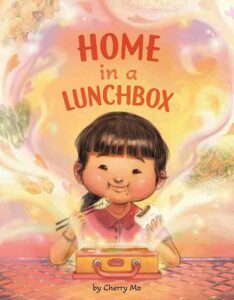
Home in a Lunchbox
by Cherry Mo
40 pages
Jun, newly arrived from Hong Kong, doesn’t understand a word of English. So how is she going to make friends at school? Young readers will get to see the world through Jun’s eyes, as she looks at a test and sees not words, but just a collection of scribbles – that’s all they are to her. On her second day, her mom teaches her the all-important word “toilet” but when she raises her hand to ask “toilet?” that gets the class giggling. Oh, it’s a tough beginning! But, there is a moment of solace each day, when Jun gets to open her lunchbox and taste a slice of home. And when a read-haired girl tentatively taps her on the shoulder to say, “Hello!” Jun offers her some of her lunch. Soon, other children are trading bits of their own lunch for a taste. That’s one way to make introductions. And when Jun invites them over after school, her mom makes a welcoming feast. Such a sweet book! And it ends with a couple of pages explaining the different foods Jun was eating. This is a great book every which way, and might also be a good way to introduce your littles to some Chinese dishes.
Honoree
Noodles on a bicycle
by Kyo Maclear and Gracey Zhang
40 pages
This begins brilliantly, with a real photograph of a Tokyo noodle deliveryman riding on a bicycle, with a load of bowls and boxes resting on his shoulder that’s stacked 8 to 10 feet high! What follows is a kid’s perspective on all the noodle deliverymen she sees biking through their neighborhood, and how the kids hop on their own bikes and see how big they can make their own stack… but their stack always comes tumbling down. The illustrations are wonderful, colorful, and would also have been completely unbelievable – it must be artistic exaggeration, right? – if not for the photograph at the beginning of the book. This is a slice of Japanese life from the 1930s-1970s (after which they got replaced by motorcycles) that’ll have kids fascinated!
Honoree
My Daddy is a Cowboy
by Stephanie Seales
41 pages
A black suburban cornrowed cowboy takes his daughter for a ride through the city in the early morning hours. I did not know that such a thing even happens, and that’s very much the appeal of this book: the wonder of cowboys in-town! Some of the pictures are a bit hard to decipher, but for a look at a lifestyle you never knew about, this is a fun read.
2023
WINNER
Hot Dog
by Doug Salati
40 pages
Averaging just about 4 words a page, this simple story is about how a very long and very hot dog needs a break from the city, so his owner takes him to the seaside where he gets to run and dig and meet seals. Peaceful, quiet, colorful, and just nice.
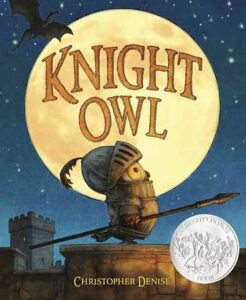 Honoree
Honoree
Knight Owl
by Christopher Denise
44 pages
Absolutely gorgeous book with full-page pictures throughout. Little owl wants to grow up to be a knight, and while it seems unlikely, his prospects pick up when knights start going missing. He graduates, with honors of course, and gets assigned the night watch, which is really rather his jam. There’s a clever bit when he asks “Whooooo is there?” and some more fun too, when he convinces a dragon to snack on something other than him. A happy end for all, including the dragon, makes this a nice gentle treat for children 3 through 9. Knight Owl and Early Bird is a worthy sequel.
2022
WINNER
Watercress
by Andrea Wang and Jason Chin
32 pages
When her parents stop to harvest watercress from the ditch, a little girl is embarrassed. Free food from a ditch? Why can’t they just get their meal from the grocery store? But then her mother shares just a little about what watercress meant to her family back in China. In the most poignant two-page spread on the left side we see a family of four around the table, and in the next picture it is a family of three, a little boy now missing, and mother explaining, “We ate anything we could find, but it was still not enough.” The little girl hears, and learns. Next page she says, “…I am ashamed of being ashamed of my family.” A beautifully drawn immigration story for children in Grades 1 and 2.
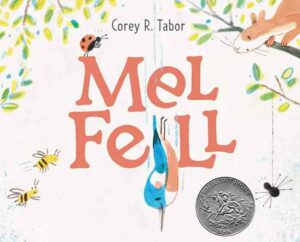 Honoree
Honoree
Mel Fell
by Corey R. Tabor
40 pages
This is a book to be read sideways – the “top” of the book left side, and the bottom the right – so when a baby bird takes her first flight she has a long way to fall: right across two pages! And as she falls the other tree critters try to save her, bees, a spider, even ants. But is she really falling… or just diving? Be sure to check out Corey Tabor’s latest, Simon and the Better Bone, inspired by Aesop’s “The Dog and His Reflection” and with a happier ending.
Honoree
Have You Ever Seen a Flower?
by Shawn Harris
48 pages
It begins in black and white as a little girl is driven out of the drab city to go see brightly colorful fields of flowers. Thereafter the colors take over in this ode to the wonder of flowers, and to the wonder of life itself.
2021
Honoree
Outside In
by Deborah Underwood and Cindy Derby
44 pages
A poetic take (though done in prose) about how we sometimes forget how wonderful the outside is. But, thankfully, outside reminds us of just how awesome it is by going inside after us. “…Outside reminds us, with flashes at the window… Outside cuddles us in clothes, once puffs of cotton…”
2020
Honoree
Bear Came Along
by Richard T. Morris and LeUyen Pham
34 pages
You know that old metaphor about the 4 blind men all feeling parts of an elephant and one thinking it was like a snake (he felt the trunk) and another thinking it was like a palm leaf (he felt the ear), and yet another thinking it was a spear (tusk). Well, together they had a pretty good picture of it. In this story an adventure is had on the river, and none of the animals are really ready for it, but when they all come together, they are. Parents could read this and talk about 1 Corinthians 12:12-27’s one body, many members.
2019
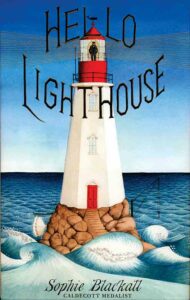 WINNER
WINNER
Hello Lighthouse
by Sophie Blackall
48 pages
A man lives out his years in a lighthouse, first by himself, then with a wife, and finally with the addition of a child. But then a letter arrives, telling the man that the day of the manned lighthouse has come to an end. The story does end on a happy note, with the little family settled on the shore, still able to see their lighthouse. It concludes with two pages on the history of manned lighthouses. The story will appeal to girls, and the lighthouse cutout will catch boys’ attention.
Honoree
Thank You, Omu!
by Oge Mora
36 pages
A grandma-ish lady makes a delicious pot of stew, and when the neighborhood smells it, they each come by, one at a time, to have a bowl. But when it is finally time for her own supper, there is none left for Omu! But grateful neighbors return her generosity in kind, each bringing a treat, and together creating a feast.
2018
WINNER
Wolf in the Snow
by Matthew Cordell
48 pages
A boy trudging through the snow, making his way home from school, comes across a lost wolf cub which he befriends and then helps find its pack back. The effort exhausts him but when he collapses in the snow the grateful wolf pack then helps his parents find him. It’s a fun story, and well drawn, but I do wonder whether, because the wolves are drawn so realistically, a little kid could read this and think it is passing on accurate information on the friendliness of wolves. It’s also featured in our 100+ Wordless Wonders article.
2017
Honoree
They All Saw a Cat
by Brendan Wenzel
38 pages
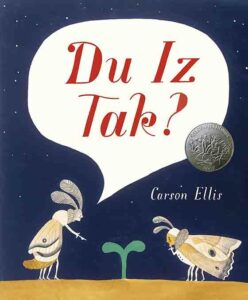 We get to see a cat through the eyes of a child, dog, fox, fish, mouse, bee, bird, flea, snake, skunk, worm, and bat. And as you might imagine, they all have quite a different take on what a cat is, with the opposite extremes taken up by the mouse, who sees the cat as a fierce monster, and the fox, who sees him as a tender morsel.
We get to see a cat through the eyes of a child, dog, fox, fish, mouse, bee, bird, flea, snake, skunk, worm, and bat. And as you might imagine, they all have quite a different take on what a cat is, with the opposite extremes taken up by the mouse, who sees the cat as a fierce monster, and the fox, who sees him as a tender morsel.
Honoree
Du Iz Tak?
by Carson EIlis
48 pages
An insect discovers a plant shoot and tells his friends about it in an invented insect language, and they gather to build homes on it. So, lots of talking in this book, but all of it made up. Lots of fun here, for kids who are up to trying to figure out what all these bugs might be saying.
2016
WINNER
Finding Winnie
by Lindsay Mattick
56 pages
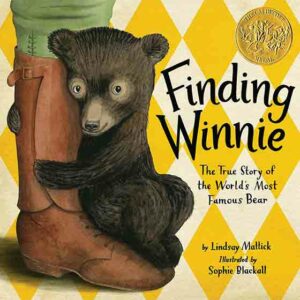 Did you know Winnie the Pooh was named after a real bear who had his own adventures? This is his story and it begins with Harry Colebourn, a veterinarian traveling across Canada by train to go fight for his country in the First World War. At a stop on the way, he met a man with a baby bear, and ended up buying the little beast. To make a long story shorter, this bear – named Winnie after Harry’s hometown – ended up in the London Zoo where a boy named Christopher Robin, and his father A.A. Milne, came across him and were utterly entranced. It is a wonderful story, but what makes it remarkable is the charming way it’s told. There is quite a difference between A. A. Milne’s Winnie tales and this author’s truth, but the same gentle humor, the same whimsy, that same charm, is there throughout. This will be for all ages!
Did you know Winnie the Pooh was named after a real bear who had his own adventures? This is his story and it begins with Harry Colebourn, a veterinarian traveling across Canada by train to go fight for his country in the First World War. At a stop on the way, he met a man with a baby bear, and ended up buying the little beast. To make a long story shorter, this bear – named Winnie after Harry’s hometown – ended up in the London Zoo where a boy named Christopher Robin, and his father A.A. Milne, came across him and were utterly entranced. It is a wonderful story, but what makes it remarkable is the charming way it’s told. There is quite a difference between A. A. Milne’s Winnie tales and this author’s truth, but the same gentle humor, the same whimsy, that same charm, is there throughout. This will be for all ages!
Honoree
Waiting
by Kevin Henkes
34 pages
Five toys on a windowsill just love to peer outside and see what they can see. A quiet book, but with an upbeat spirit. A warning for sensitive little souls: on one page an elephant figurine visits and “leaves” never to come back, but we see him broken on the ground.
2015
Honoree
Sam & Dave Dig a Hole
by Mac Barnett and Jon Klassen
40 pages
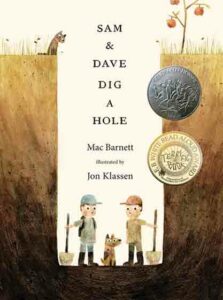 Two boys dig a hole and they won’t stop digging until they find something spectacular. Some kids will really appreciate, and I suspect others will get increasingly frustrated, at the pair’s many near misses.
Two boys dig a hole and they won’t stop digging until they find something spectacular. Some kids will really appreciate, and I suspect others will get increasingly frustrated, at the pair’s many near misses.
Honoree
Nana in the City
by Lauren Castillo
40 pages
A boy goes to visit his Nana in the big city. He finds it a busy, loud, scary place, and thinks his Nana should move. But the next day his Nana shows him how the city is a busy, loud, extraordinary place, just right for his Nana to live in… and for him to visit.
Honoree
The Right Word: Roget and His Thesaurus
by Jen Bryant and Melissa Sweet
44 pages
The life and times of Peter Roget (1779-1869), whose popular thesaurus is still being published today. It includes lots of detailed word lists from Roget’s original thesaurus. That makes it colorful but also a bit much for Grade 1 and under. Could be fascinating to certain kids in Grade 2 and older.
2014
WINNER
Locomotive
by Brian Floca
66 pages
A prose/poetry account of how the cross-America railway was built, and what it was like to ride on it. While it is an attractive book, it struck me as having too much text for a picture book, and as too picture-bookish for the Grade 3-5 readers this would be best suited for. Split the difference and pitch it to Grades 2 and 3.
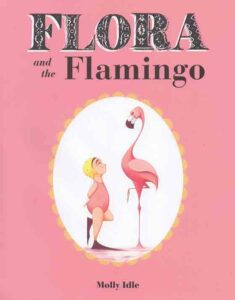 Honoree
Honoree
Flora and the Flamingo
by Molly Idle
44 pages
In this wordless wonder, Flora dances an elegant and energetic duet with a flamingo. My favorite of the “Flora’s feathered friends” series is the 2014 sequel, Flora and the Penguin, which sees her switch up dance partners, and Flora and the Peacocks (2016), which has her dancing with two others for even more fun. The only downside is that they include flaps and foldouts that might need reinforcement to hold up to school library use. But if you’re buying it for a child or grandchild who likes to dance, these will be inspirational. (Don’t confuse these with the two other “Flora books” – featuring an ostrich in one, and baby chicks in the other – which are board books intended for babies.)
Honoree
Journey
by Aaron Becker
40 pages
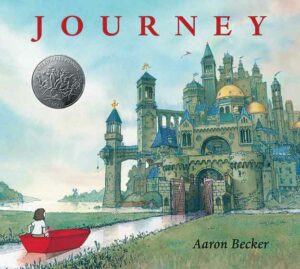 If your children loved Crockett Johnson’s Harold and the Purple Crayon you’ll want to check this one out. While Johnson wrote her own sequels, Aaron Becker’s Journey might be the most worthy successor. There are some notable differences: Harold’s world is a blank page, ready to be drawn on, while Journey has lavish full-color spreads; Harold is narrated, while Journey is a completely wordless book. But in both books, a child equipped with a large crayon and an even larger imagination sets out on an adventure of their own crafting. In Journey, a girl’s dad, mom, and sister are all too busy to play with her, but when she finds a large red crayon on her bedroom floor she discovers she can make her own fun. She uses the crayon to draw a door on her wall, which she can then open and walk through into a whole other world of wonder. A quickly drawn red boat allows her to float down a forest stream to a castle that has moats running all throughout it, and friendly guards who wave her through. Like Harold, she too, in a moment of quick thinking, conjures up a balloon to save herself from a big fall. The adventure continues into the clouds, where she comes upon a strange king, his stranger airship, and an imprisoned beautiful purple bird that looks almost as if someone – someone with a purple crayon – had drawn it! Of course, she has to free the bird, and of course it isn’t easy, leaving her requiring some rescuing herself. In the sequel, Quest (2014), red crayon girl, and the purple crayon boy she meets at the end of the previous book meet an orange crayon king right before he is dragged away by soldiers. They set out to rescue him, using their own crayons and the orange crayon the king left behind. But to do that, they need to find three more crayons and, as the title indicates, have to go on a quest, and they’ll have draw the tools and the animal friends they’ll need along the way. The conclusion to this wordless trilogy is Return (2016), in which the girl’s dad discovers the red door in his daughter’s bedroom and enters this other world in search of her. While the girl rescues them both with a quickly drawn submarine (these crayons work even underwater!), it’s dad who devises and draws (Wait, he has a crayon too? Has he been here before?) the trap that catches the evil king. These are all great fun, and deserve a slow “read” and then “reread” as children will be sure to notice all sorts of details on a second run-through.
If your children loved Crockett Johnson’s Harold and the Purple Crayon you’ll want to check this one out. While Johnson wrote her own sequels, Aaron Becker’s Journey might be the most worthy successor. There are some notable differences: Harold’s world is a blank page, ready to be drawn on, while Journey has lavish full-color spreads; Harold is narrated, while Journey is a completely wordless book. But in both books, a child equipped with a large crayon and an even larger imagination sets out on an adventure of their own crafting. In Journey, a girl’s dad, mom, and sister are all too busy to play with her, but when she finds a large red crayon on her bedroom floor she discovers she can make her own fun. She uses the crayon to draw a door on her wall, which she can then open and walk through into a whole other world of wonder. A quickly drawn red boat allows her to float down a forest stream to a castle that has moats running all throughout it, and friendly guards who wave her through. Like Harold, she too, in a moment of quick thinking, conjures up a balloon to save herself from a big fall. The adventure continues into the clouds, where she comes upon a strange king, his stranger airship, and an imprisoned beautiful purple bird that looks almost as if someone – someone with a purple crayon – had drawn it! Of course, she has to free the bird, and of course it isn’t easy, leaving her requiring some rescuing herself. In the sequel, Quest (2014), red crayon girl, and the purple crayon boy she meets at the end of the previous book meet an orange crayon king right before he is dragged away by soldiers. They set out to rescue him, using their own crayons and the orange crayon the king left behind. But to do that, they need to find three more crayons and, as the title indicates, have to go on a quest, and they’ll have draw the tools and the animal friends they’ll need along the way. The conclusion to this wordless trilogy is Return (2016), in which the girl’s dad discovers the red door in his daughter’s bedroom and enters this other world in search of her. While the girl rescues them both with a quickly drawn submarine (these crayons work even underwater!), it’s dad who devises and draws (Wait, he has a crayon too? Has he been here before?) the trap that catches the evil king. These are all great fun, and deserve a slow “read” and then “reread” as children will be sure to notice all sorts of details on a second run-through.
2013
Honoree
Green
by Laura Vaccaro Seeger
34 pages
All about the different sorts of green. With just 33 words in 34 pages, this is not a heavy read. It is on heavy stock paper, though, which allows for cutouts on most pages, allowing the colors from the next and previous pages to peek through. It’s clever, and the paper is thick enough that it should survive library usage.
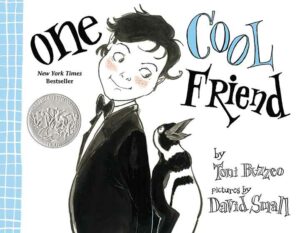 Honoree
Honoree
One Cool Friend
by Toni Buzzeo and David Small
32 pages
When Elliot and his father visit the aquarium, the boy asks dear old dad for a penguin. Dad thinks he means a stuffed one, and says yes. But Elliot did not. The confusion continues as Elliot takes a smallish one home in his backpack and turns his room into an antarctic setting. Fun throughout, with a twist at the end just for parents (as I don’t know that kids will catch this last joke). This is one of three books David Small has on this list (see The Gardener and So You Want to Be President? further on down) and I’ll just mention a couple of other favorites. In Imogene’s Antlers, a girl is surprised to wake up one morning with a set of antlers on her head. It doesn’t faze her though, as she runs with it, using them to dry laundry and hang donuts, and it is her optimistic outlook that makes this such fun. In the sequel, Imogene Comes Back, her antlers are gone, but now she has a giraffe neck, and the next day an elephant nose… and she’s still as upbeat as ever!
Honoree
Extra Yarn
by Mac Barnett and Jon Klassen
40 pages
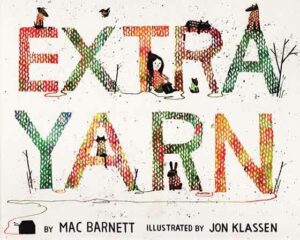 A girl in a cold little town of buildings blackened by soot, and streets whitened by snow, finds “a box filled with yarn of every color” with which she knits sweaters for everyone in town, and even for the animals and buildings, and still the box remains full of yarn. A goofy little story that might, perhaps, inspire a reader or two to take up knitting.
A girl in a cold little town of buildings blackened by soot, and streets whitened by snow, finds “a box filled with yarn of every color” with which she knits sweaters for everyone in town, and even for the animals and buildings, and still the box remains full of yarn. A goofy little story that might, perhaps, inspire a reader or two to take up knitting.
2012
WINNER
A Ball for Daisy
by Chris Raschka
32 pages
Daisy is a cute little pup who loves her big red ball and plays with it everywhere. Things take a tragic turn when another dog, trying to get in on the fun, pops the ball! But don’t worry, a happy ending is coming – after a few pages of Daisy being sad, the owner of the dog who popped the ball brings over a brand new one, and this time it is blue. A 2013 sequel, Daisy Gets Lost, has a half dozen more words than the wordless original but has the same quiet tension: Daisy chases her blue ball into the woods, then chases the squirrel she discovers, and gets lost for a dozen or so pages before being rescued and hugged by the little girl who owns her.
Honoree
Blackout
by John Rocco
40 pages
When the electricity goes out all over the city, one family discovers the wonders of not being off on their own phones, computers, and devices. Told in a comic-book style, this is an attractive, friendly book (even if big sister is a bit unfriendly at the beginning, telling her little sister to “Get out!”).
2011
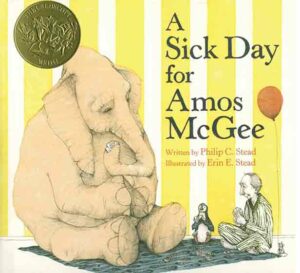 WINNER
WINNER
A Sick Day for Amos McGee
by Philip C. Stead and Erin E. Stead
32 pages
First we get to see Amos in his routine: early rising, on to the bus to work, and then it’s chess with the elephant, races with the tortoise, stories with owl, and quiet time with the penguin. Amos, you see, is a zookeeper. But when he gets sick and has to stay home, his animals reverse his routine, starting with hopping on the bus to visit sick Amos. Sweet and quiet – as my sister-in-law noted, a perfect going-to-bed book for ages 3-8. A 2021 sequel, Amos McGee Misses the Bus, is just as sweet, with his animal friends helping out once again. However, a one-page foldout might make this problematic for library usage (they always seem to get torn or folded up wrong).
Honoree
Interrupting Chicken
by David Ezra Stein
40 pages
When Little Chicken’s dad reads him some classic fairy tales, the young’un can’t help but interrupt and warn Red Riding Hood not to talk to the Wolf, Hansel and Gretel not to go into the witch’s house, and Chicken Little that it was just an acorn. I was worried this might be a rude book, but the little chicken is just exuberant. There are at least a couple of sequels, including Interrupting Chicken: Cookies for Breakfast, done with nursery rhymes this time, that was also very fun. Kids already familiar with the originals will love both. Recommended for ages 3-9.
Honoree
Dave the Potter
by Laban Carrick Hill and Bryan Collier
40 pages
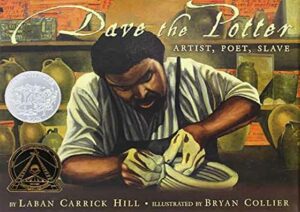 Nearly 200 years ago an American slave made thousands of clay pots, some small and others enormous, signed his name on some, and on a select few, also included a couple of lines of poetry. Dave the Potter was a master craftsman, but all we know of him is what he told us in these select few lines of poetry. This is a fascinating, beautifully illustrated book that shows what Dave might have had to do, to transform clay into his pots. The last 4 pages are just text, explaining what we know about Dave in a little more detail. Good for Grade 2 and up. There is a fold-out though, that might need reinforcing.
Nearly 200 years ago an American slave made thousands of clay pots, some small and others enormous, signed his name on some, and on a select few, also included a couple of lines of poetry. Dave the Potter was a master craftsman, but all we know of him is what he told us in these select few lines of poetry. This is a fascinating, beautifully illustrated book that shows what Dave might have had to do, to transform clay into his pots. The last 4 pages are just text, explaining what we know about Dave in a little more detail. Good for Grade 2 and up. There is a fold-out though, that might need reinforcing.
2010
WINNER
The Lion and the Mouse
by Jerry Pinkney
40 pages
When a tiny mouse disturbs the rest of the King of the Beasts, the King seems intent on having a quick snack. But instead, after some back and forth with the tiny petitioner, the lion lets the mouse go. Why? Readers already familiar with this Aesop’s tale will remember that the mouse has pledged to help the king if ever he is in trouble. But in Pinkney’s almost entirely wordless version – there are only a few squeaks, one owl screech, and a lion’s roar – it isn’t as clear. But no worries, we can follow along well enough. Then when hunters trap the mighty lion in a net, it is the mouse that comes to the rescue, chewing through the rope to set the lion free. The moral of the story? Even the strongest will need help. Pinkney had a lot of others worth checking out, which we review here.
Honoree
Red Sings from Treetops
by Joyce Sidman and Pamela Zagarenski
32 pages
We are taken through the four seasons and shown how the colors yellow, blue, white, gray, purple, and black make their appearance in each one. The art – particularly the people – is both wonderful and a little weird, giving the book a strange charm.
2009
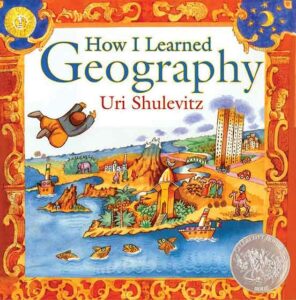 Honoree
Honoree
How I Learned Geography
by Uri Shulevitz
32 pages
When his family has to flee to another country, and they have just a room to call their own, a boy gets angry with his father for buying a giant world map instead of food. But later he concludes his father was right – they went without food one night, but that map brought color to the whole room, and transported him in his imagination to all these far-off places. I’d also recommend Shulevitz’s The Secret Room, about a man both clever and humble.
2008
Honoree
Knuffle Bunny Too: A Case of Mistaken Identity
by Mo Willems
48 pages
Trixie has grown up in this second knuffle bunny book (see below for the first) and takes her bunny to school only to discover another girl has one too. And when they argue over how to say “knuffle” (is the “k” silent or not?) the teacher confiscates both bunnies, returning them only when they head for home. But what do both girls discover that night? They have the wrong bunny! But, they both have pretty special dads, who ride to the rescue. A great sequel to the original, and a third in the series, Knuffle Bunny Free, is every bit as good.
Honoree
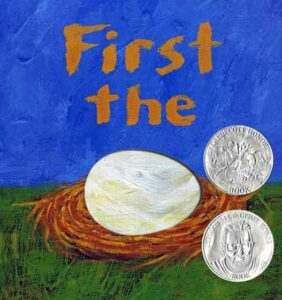 First the Egg
First the Egg
by Laura Vaccaro Seeger
28 pages
Which came first, the chicken or the egg? In this book we’re told “First the egg” and then as the page turns, “then the chicken” but the real fun here is that the egg is actually just an egg-shaped hole in the page, and the white shell comes from the white feathers of the chicken on the next page. Sturdy paper stock means these cutouts on every fourth page should survive library reading. After “First the tadpole… then the frog” and “First the seed… then the flower” we eventually get back to “First the chicken…. then the egg.” Simple fun for ages 3 to 8.
Honoree
Henry’s Freedom Box: A true story from the Underground Railroad
by Ellen Levine and Kadir Nelson
40 pages
This is the true story of Henry “Box” Brown, an American slave whose wife and children were sold away from him. Afterwards he decided to mail himself in a large crate, special delivery to the North where he could be free. This is told in a careful, somewhat muted manner, but might be a bit much for Grade 1, so I’d recommend it for at least Grade 2 and up.
2006
WINNER
The Hello, Goodbye Window
by Norton Juster and Chris Raschka
32 pages
This is a sweet story about a child who loves to visit her grandparents’ home, which only ranks somewhat low in my estimation because I don’t know if a kid will pick this up – too many words for an early reader, and pictures too childish for Grade 2 and up. However, I think grandparents might really enjoy reading this to a little one.
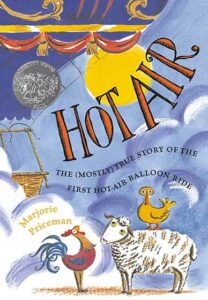 Honoree
Honoree
Hot Air: The (Mostly) True Story of the First Hot-Air Balloon Ride
by Marjorie Priceman
40 pages
In 1783 a trio of flyers took to the sky. No, this wasn’t the first manned flight, but it might have been the first “animaled” balloon flight – a rooster, a sheep, and a duck sailed off in this grand experiment. The story is introduced in detail, but the flight itself is told from the perspective of the three animals, and thus, wordless (though there are some baaaaahs and such). Very colorful balloon pictures make this a visual delight, and an explanation in the back of what may have actually happened, make this educational.
Honoree
Rosa
by Nikki Giovanni and Bryan Collier
32 pages
Rosa Parks boarded a city bus in Montgomery, Alabama, on December 1, 1955, and took a seat somewhere in the middle. When the bus filled up, she was asked to give up her seat. Why? Because she was black, and someone white needed a seat – it was a rule that blacks had to make way for whites. But Mrs. Parks said no, she would not get up. She was arrested, which sparked a protest – blacks in the city and white folk who supported them stopped using the buses. That was a tough way to protest – it’s not like they all had cars they could use instead. The protest lasted a year as Parks’ court case made its way to the US Supreme Court, where she eventually won. This is an intense book, well told, which serves as an example of how courts can be used to hold governments accountable. One caution is just that racism, civil disobedience, and one level of government (the courts) holding another accountable is, in my mind, a bit much for Grade 1 or 2. Yet picture books are seen as a bit childish by Grade 3 and up, so who is actually going to read this? It is both educational and interesting, so with some help from teachers or parents, who’d need to place this in older kids’ hands, this could be a much-appreciated book (my 6th-Grader thought it was “cool”). One practical concern is a two-page foldout that will need some reinforcing if this is bought for a school library.
Honoree
Song of the Water Boatman
by Joyce Sidman and Beckie Prange
32 pages
This is poetry paired with science and full-page art. Each two-page spread has a poem about some pond critter – plant, animal, or bug – and on the facing page we get a concise, under 100 words, briefing on what this creature is like. This is not a picture book most kids would pick up on their own, but I think its super creative way of educating us on pond life could make it a favorite among teachers, Grade 2 and up, for their science classes.
2005
WINNER
Kitten’s First Full Moon
by Kevin Henkes
34 pages
Kitten sees a big bowl of milk in the sky – the full moon! But try as she might she just can’t reach it, ending up soggy and defeated. But when she returns home she discovers a happy delicious ending to her night.
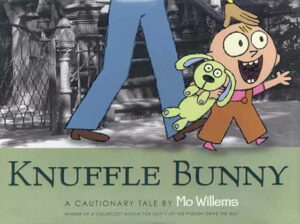 Honoree
Honoree
Knuffle Bunny: A Cautionary Tale
by Mo Willems
36 pages
This is the original knuffle book – a little girl loses her little “knuffle” bunny at the laundromat, and has to figure out how to tell her dad. Except she doesn’t know how to talk yet. This features a really attractive combination of cartoon art, and real photography.
Honoree
The Red Book
by Barbara Lehman
32 pages
This is a wordless story about a boy who discovers a red book in the sand, and a girl elsewhere who finds a red book in the snow. Each opens it to find themselves looking at a picture of the other. The girl then buys a gazillion balloons and manages to sail into the sky to find the boy on the beach. Weird but wonderful. Kids who enjoy this mystery will enjoy the sequel Red Again (2017) which is more mysterious still. In fact, they should be bought as a set, with the ending of the one serving as an introduction to the next, and vice versa (or as my one daughter put it “They’re a circle!”).
2004
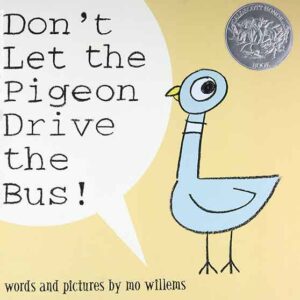 Honoree
Honoree
Don’t Let the Pigeon Drive the Bus!
by Mo Willems
40 pages
Pigeon really wants to drive the bus, but the bus driver is trusting us that we won’t let him… no matter how much he begs. The fun in this book is that pigeon is very creative in his reasons, whines, and promises, to try and get us to change our mind – children will understand they sound like pigeon sometimes. And they get to take the parental role of saying no, no, and no! Parents can read this one with their child to create some shared vocabulary. In our house, at one time we could tell our kids “You sound a bit like pigeon right now.” And there are seven others in this series. And if you don’t know about it already, you’re going to love Willems’ fantastic 25-book Elephant and Piggie series!
2003
WINNER
My Friend Rabbit
by Eric Rohmann
32 pages
When rabbit sails mouse’s toy plane high into a tree, he has an inventive idea of how they can get it back – stacking animals, starting with an elephant, hippo and rhino. They all eventually go tumbling, but the plane is retrieved. Mouse loves rabbit, even if trouble follows him wherever he goes. Bright colors and sparse text make this a good one for early readers. Recommended for 3-7.
Honoree
Hondo & Fabian
by Peter McCarty
32 pages
A dog and cat start their day together, then go their separate ways as Hondo heads out to the beach to run around with another dog, and Fabian stays home, trying to escape the attentions of the baby.
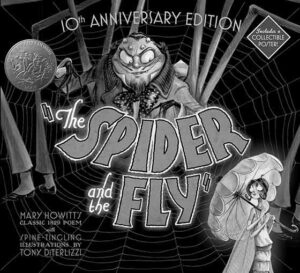 Honoree
Honoree
The Spider and the Fly
by Mary Howitt and Tony DiTerlizzi
38 pages
I wasn’t going to recommend this one, because it’s creepy. The text is based on an 1829 poem whose opening lines are famous to all: “‘Will you walk into my parlor?’ said the Spider to the Fly.” Adults all know how that invitation is going to turn out, and we’ll appreciate the moral to the story: don’t let flattery entice you into listening to bad sorts. Another highlight is the stunning black and white artwork, though that excellence only makes the well-dressed spider all the creepier. This is really a rather amazing work, but the problem is, in this picture book setting, the demise of the Fly is going to come as quite a shocking surprise to its young readers. So, don’t get this for your Christian school library, where it will just be in the general mix and freak out a lot of unsuspecting little tots looking for a happy ending. But this could be a good one to take out of your public library to read along with your child, and use the shock to really drive home the moral.
2002
WINNER
The Three Pigs
by David Wiesner
40 pages
When our middle daughter discovered this one she just had to share it with her younger sister right there and then. This is a creative spin on the old tale as the Big Bad Wolf blows the pigs right out of the story and into some others (including Wiesner’s own The Loathsome Dragon). As they travel from storybook to storybook the pigs decide there is no place like home, but also decide to bring along a guest from another story – a dragon! – to give this pesky wolf quite the surprise. There are two more Wiesner Caldecott winners below, and we review all his books here.
2001
Honoree
Click, Clack, Moo: Cows That Type
by Doreen Cronin and Betsy Lewin
34 pages
When Farmer Brown’s cows get ahold of a typewriter, they start making some demands: “The barn is very cold at night. We’d like some electric blankets. Sincerely, The Cows.” When Farmer Brown won’t listen, they take it up a notch with their next note: “Sorry. We’re closed. No milk today.” Then the hens get in on the action and type up their own note. Ridiculous fun!
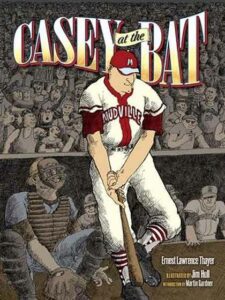 Honoree
Honoree
Casey at the Bat
by Ernest Lawrence Thayer and Christopher Bing
3o pages
The original 1888 poem is paired with detailed black and white drawings – almost photo quality – and short newspaper clippings discussing stories that could have appeared in the papers of 135 years ago. Fantastically executed and best appreciated by Grade 2 and up.
2000
WINNER
Joseph Had a Little Overcoat
by Simms Taback
36 pages
When Joseph’s overcoat gets worn, he turns it into a jacket. When his jacket gets worn he turns it into a vest, and so on and so on, until he’s left only with a button… which he loses. But no worries, because he then writes about it, turning it into this book! Clever small cutouts on every fourth page give us a glimpse into what’s coming and what was and because the book’s pages are extra thick, this is still practical for a school library – they won’t be easily torn. This is great for kids 3 through 8, who will also like Phoebe Gilman’s Something from Nothing, based on the same Yiddish tale.
Honoree
Sector 7
by David Wiesner
48 pages
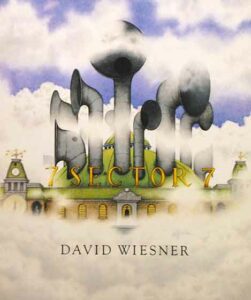 A boy on a field trip to the Empire State Building meets a rambunctious cloud (he discovers that clouds are people!) who takes him back to “Sector 7” high up in the sky where the clouds get their orders about what shape of cloud they should be. But the clouds seem a bit bored with these shapes and ask the boy to draw them up some alternatives. What fun to see clouds mimicking the sea creatures he draws! Eventually, the cloud returns the boy, but his visit to Sector 7 might have some lasting impact, as the clouds quite like being fish-shaped.
A boy on a field trip to the Empire State Building meets a rambunctious cloud (he discovers that clouds are people!) who takes him back to “Sector 7” high up in the sky where the clouds get their orders about what shape of cloud they should be. But the clouds seem a bit bored with these shapes and ask the boy to draw them up some alternatives. What fun to see clouds mimicking the sea creatures he draws! Eventually, the cloud returns the boy, but his visit to Sector 7 might have some lasting impact, as the clouds quite like being fish-shaped.
Honoree
The Ugly Duckling
by Jerry Pinkney
40 pages
Everyone seems a little bit nicer (or maybe a little less mean) to the ugly duckling in Pinkney’s version, though he does still get picked on for looking so different from the other ducklings. It’s only when he discovers he is a swan, not a duck, that he finds his place in the world. The moral to this story is one that parents can shape to a degree: is it about finding the right peer group – one that will accept you for who you are – or is what’s important finding out who God intends you to be?
1999
WINNER
Snowflake Bentley
by Jacqueline Briggs Martin and Mary Azarian
32 pages
The true story of a farmer who made it his life’s study to dig into the beauty of snowflakes. We take it for granted now, the close-ups we’ve seen of these crystalline marvels, but it’s quite a trick to take a picture of something so small and fragile. And he figured it out. The expression that “no two snowflakes are alike” comes from his efforts. This can be tackled at two different speeds, with extra material for older kids to chew on, so I’d recommend it for Grades 1 through 6.
Honoree
Snow
by Uri Shulevitz
32 pages
A young boy is excited about the first snowflake. But it’s just one, says his grandfather. But one is followed by two, and then three and more, and finally the gray town is turned a delightful white!
1998
Honoree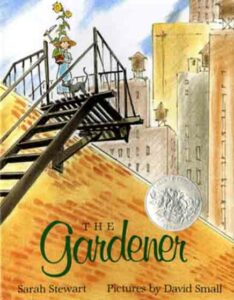
The Gardener
by Sarah Stewart and David Small
38 pages
Lydia Grace Finch’s family has fallen on hard times, so the little girl is sent off to the city to live with her baker uncle Jim, to help him around the shop. The story is told via her short letters home, where she updates the family on her efforts at making her somber uncle smile, and the garden she is growing, both in the window boxes where everyone can see, and in secret, on the roof of the building. Will she get her uncle to smile with all the beauty? I really loved this one – a sweet story with art that fills every corner of every page. Sarah Stewart and David Small have also teamed up for the wonderful The Quiet Place, an immigration story where a young girl, who has moved to the US, sends letters back to her aunt in Mexico. Learning a new language and making new friends can be overwhelming, so she is grateful when she is able to turn a big box into her own quiet place.
1997
Honoree
The Paperboy
by Dav Pilkey
32 pages
This is a throwback to the author’s life, when paperboys would get up before the crack of dawn to deliver papers by bike. It’s a pleasant look back.
Honoree
Hush! A Thai Lullaby
by Minfong Ho and Holly Meade
32 pages
A Thai mother takes all sorts of animals to task for their peeping, creeping, squeaking, leaping, sniffling, beeping, and shrieking during her baby’s nap time. Quite the diligent mom to even wag her finger at a nosy elephant. Lots of repetition in the mother’s warning for each animal, which could make this a good nap time read for preschoolers (though that same repetition is what makes this one I’d want to borrow and not own – I’d only have the patience to read it so many times).
1996
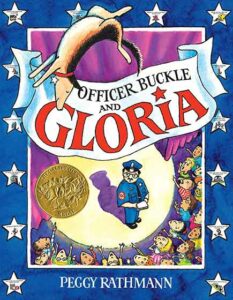 WINNER
WINNER
Officer Buckle and Gloria
by Peggy Rathmann
36 pages
Officer Buckle loves passing on safety tips. But the kids he’s talking to aren’t as enthused… until he brings his dog Gloria along. Unbeknownst to the officer, Gloria is acting out the consequences of ignoring each safety tip, much to the appreciation of the students. Suddenly Officer Buckle is getting invited to speak everywhere, and told to bring his dog. When he finally finds out what Gloria is doing, it puts him in a bit of a funk. But it turns out, not only does he need Gloria, she can’t do the talk without him either. The moral of this hilarious story is, keep your buddy close. A really fun one for kids 3-10.
Honoree
Zin! Zin! Zin! a violin
by Lloyd Moss and Majorie Priceman
32 pages
Children will learn the names of the many instruments in an orchestra via this rhyming introduction.
Honoree
Tops & Bottoms
by Janet Stevens
36 pages
A rabbit family needs to earn some money so they make a deal with the lazy bear next door that they’ll plant his fields for him, and split it 50/50. Rabbit asks Bear ahead of time which half he would like, “The top half or the bottom half?” Bear picks the top half, and so the clever rabbit plants all root crops. When the bear gets his half at harvest, he demands that next season he get the bottoms. So, of course, the rabbit plants lettuce, broccoli, celery and more above-ground foods. Eventually, the bear learns that if he wants any proceeds, he better put in the work himself. The book has a unique layout, with the book held sideways so that the normal left page is actually the top, and the right page is the bottom. But it is a problem that the “hero” of the story is taking advantage of the lazy bear.
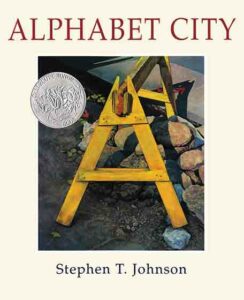 Honoree
Honoree
Alphabet City
by Stephen T. Johnson
32 pages
In this clever alphabet book, kids can find one letter per page hidden in a picture of their everyday urban surroundings.
1995
Honoree
Time Flies
by Eric Rohmann
32 pages
A bird flies into a museum, and flutters around the ancient dinosaur skeletons, which, for reasons unexplained, come alive. Or has the bird simply been transported back in time? It’s unclear, but what’s very clear is how cool these dinosaur pictures are. And because there are no words, there’s no evolutionary proselytizing – hurray!
1994
WINNER
Grandfather’s Journey
by Allen Say
30 pages
True story of a Japanese man immigrating to America in the early 1900s, traveling the country by train and riverboat, bringing his bride over to him in California, and then eventually moving back to Japan, only to have his grandson, the author, follow in his footsteps and move to America. Ends on a poignant note that might make some sensitive kids a bit sad:
“The funny thing is, when I am in one country I am homesick for the other. I think I know my grandfather now. I miss him very much.”
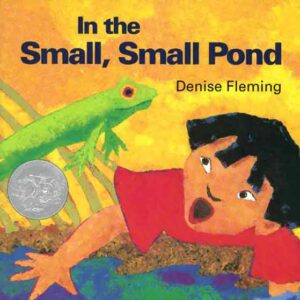 Honoree
Honoree
In the Small, Small Pond
by Denise Fleming
32 pages
A girl’s visit to a small, small pond is told with bright pictures and very few words, making this a great one for kids just learning to talk, or kindergarteners just learning to read. A dozen animals are featured, each with their own rhyming descriptors like: “lash, lunge, herons plunge” and “splitter, splatter, minnows scatter.” This is a sequel of sorts to Fleming’s In the Tall, Tall Grass, which is every bit as fun.
Honoree
Yo! Yes?
by Chris Raschka
32 pages
Two boys, strangers at the start, become friends over the course of this series of one- and two-word exchanges. Probably less than 40 words total, in a book well suited for Kindergarten and First Grade.
1993
Honoree
Seven Blind Mice
by Ed Young
40 pages
Seven blind mice encounter a “Something,” and each in turn, takes a feel to figure out what it is. The reader will know from the start that it is an elephant from the pictures, but when the first mouse feels its foot he thinks it a pillar. The second feels the elephant’s trunk and thinks it a snake. The third feels a tusk and thinks it a spear. And so on it goes, each mouse disagreeing with those that went before, until we get to mouse #7. He figures out that he should take a little more time and feel more. And when he runs across the whole elephant, he can share the whole truth with his brothers. And that’s the moral of the story, that wisdom comes from seeing the whole. This book can also be used to rebut relativism, the notion that we each have “our own truth.” The first six mice thought they did, but the one real truth was actually yet to be discovered.
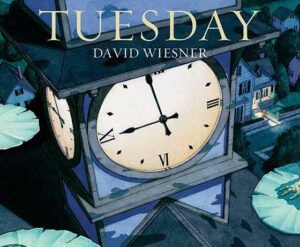 1992
1992
WINNER
Tuesday
by David Wiesner
32 pages
The only words we see tell us the time, and that it is a Tuesday. For reasons that are left entirely mysterious, at around 8 pm, a swarm of frogs suddenly starts flying (or is it their lily-pads that are doing the levitating?). They flock into town, chase some birds for fun, watch a little telly, and then, just as they are heading back, dawn breaks, and the sun’s rays seem to sap their flying powers. That leaves the whole lot of them hopping back to their pond. This is silly nonsense and kids are sure to love it.
1991
WINNER
Black and White
by David Macaulay
32 pages
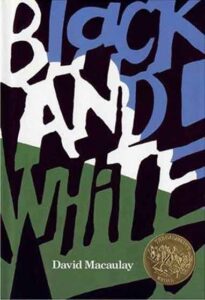 This unique book has four stories being told simultaneously on each two-page spread. Or is it all just one story? Very fun, but not for the impatient, as the answer reveals itself slowly.
This unique book has four stories being told simultaneously on each two-page spread. Or is it all just one story? Very fun, but not for the impatient, as the answer reveals itself slowly.
Honoree
“More More More,” Said the Baby: 3 Love Stories
by Vera B. Williams
36 pages
Each of these 3 stories involves a baby and an adult who loves them very much. In the first it is dad who is chasing down “Little Guy” and swinging him all around, and kissing his belly button. “‘More,’ laughed Little Guy. More. More. More.” A wonderful read for toddlers, but only if parents are up for a little roughhousing afterward.
1990
WINNER
Lon Po Po: a Red Riding Hood story from China
by Ed Young
32 pages
The familiar story of Red Riding Hood is given a twist: this time grandma doesn’t get eaten, there are three children, and with no woodcutter coming to save them, they have to figure things out themselves. Like the original, this account is a little grim – the wolf does not get out alive – so this might be best read with mom and dad along for comfort. For ages 5-9.
Honoree
Color Zoo
by Lois Ehlert
36 pages
This is a very clever cutout book; it uses three layers of cutouts – circle, square, and triangle – to form the first animal, a tiger. Then, as you flip the page, there are only two layers left – the square and triangle cutouts – which form a mouse. Flip the page once more, and the one remaining cutout – a triangle – is the basis for a fox. If it’s still not all that clear in your head, I’ll readily concede this has to be seen to be understood. It is done on thick paper stock so it should survive a lot of use, and covers animals, colors, and shapes, for ages 2 through 8.
1989
WINNER
Song and Dance Man
by Karen Ackerman and Stephen Gammell
32 pages
A bright, colorful story about a grandpa who used to be a “song and dance” man on the vaudeville stage, pulling out his old hat, cane, and shoes, to put on a wonderful performance for his grandchildren!
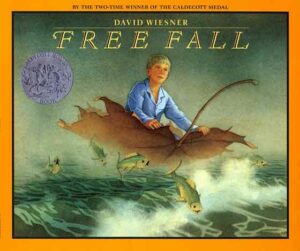 Honoree
Honoree
Free Fall
by David Wiesner
32 pages
A little boy falls asleep and we get to come along in his dream. As dreams often are, this is wordless throughout, one page streaming into the next as the boy goes from meeting a dragon to growing giant-sized, to flying home on a leaf. It makes sense only in the ways that dreams do. But the smart-eyed reader will be able to spot on the last page, when the boy wakes up, all the objects in the room that inspired the different parts of his dream. This is one to “read” slowly and enjoy every picture.
Honoree
Goldilocks and the Three Bears
by James Marshall
32 pages
The classic tale is retold with bright cheerful art, and a small twist: this is one of the only times I can think of where Goldilock’s rudeness – just barging into a house and eating their food and going through their stuff – is actually acknowledged. Goldi does escape in the end, and thankfully the bear family never sees her again!
1988
WINNER
Owl Moon
by Jane Yolen and John Schoenherr
32 pages
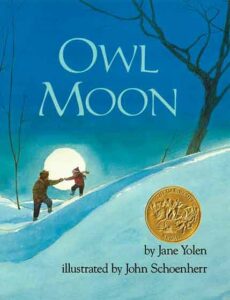 A girl goes “owling” with her father for the first time, heading out into the crisp snow. The forest is a little scary, but “when you go owling you have to be brave.” Their hike includes regular stops, with pa making his owl calls, at last rewarded when finally they hear a hoot in return, and a feathered friend descends right on the branch above them. Then, for one whole minute (or is it one hundred?) they stare at one another. A cozy story about a father sharing a wonder with his daughter, good for ages 3 through 9.
A girl goes “owling” with her father for the first time, heading out into the crisp snow. The forest is a little scary, but “when you go owling you have to be brave.” Their hike includes regular stops, with pa making his owl calls, at last rewarded when finally they hear a hoot in return, and a feathered friend descends right on the branch above them. Then, for one whole minute (or is it one hundred?) they stare at one another. A cozy story about a father sharing a wonder with his daughter, good for ages 3 through 9.
1987
WINNER
Hey Al
by Arthur Yorinks and Richard Egielski
30 pages
A man and his (talking) dog live in a one-room apartment in New York and are having a hard time just getting by. The dog in particular is a bit whiny about it, but the story takes an amusing turn when a giant bird invites them both to a tropical island where they can relax. Things are going great – they both love it – until one day they find they are turning into birds. That’s not a trade they want to make so they flutter back home, losing feathers along the way, and learning the lesson of appreciating what they had back in New York. Colorful pictures give this one a boost. Best for 5 through 8.
1986
Honoree
The Relatives Came
by Cynthia Rylant and Stephen Gammell
32 pages
It’s summer so that means the relatives are coming! For any large family spread out across the breadth of this continent, this will be a familiar story, though taken to fun extremes – a horde of relatives are coming for an extended visit, and there’s no room so they’ll all just sleep on the floors and on top of each other. Bright, vibrant pictures add to the affection, as everyone is just so glad to see each other!
1985
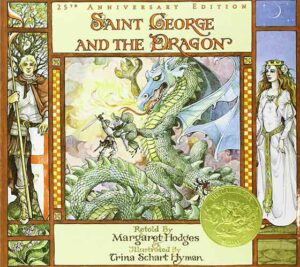 WINNER
WINNER
Saint George and the Dragon
by Margaret Hodges and Trina Schart Hyman
32 pages
This is an epic knight vs. dragon tale, retold in gorgeous illustrations that are detailed, and, while not gore-free (we do see blood spurting from the dragon’s tail when it gets cut off) certainly not gory. Both children and adults will enjoy time just pondering the pictures – when people talk of visual feasts, this is what they mean. The only caution I can add is a bit comical – there is some small elfish immodesty in these pages. The elves are not part of the story (they are a part of the larger Edmund Spenser tale “Faerie Queen,” of which this is an extracted part) but appear on the title page, and in small pictures that frame each page’s big center image. The elves, in one or two instances, are entirely naked, but the pictures are so small as to be easy to miss, and the elves themselves so childlike as to be quite innocent-looking. Nothing lascivious here and I mention it only so that those who might find such pictures objectionable aren’t surprised by them. This might not be a going-to-bed book – too exciting – but otherwise would be for ages 3-9. And their dads will enjoy reading it to them.
Honoree
Have You Seen My Duckling?
by Nancy Tafuri
26 pages
When a mama duck loses one of her charges, she paddles around the pond asking the beaver, fishes, and even a frog or two, “Have you seen my duckling?” The missing chick is eventually brought home by the turtle, and if a child is paying attention, then he’ll have noticed that the turtle showed up early, and stayed around lurking on the corners of each spread of pages. And a really keen eye will notice the missing duckling off in the distance of each set of pages too. The duckling isn’t lost; she’s always right near by!
1984
WINNER
The Glorious Flight: Across the Channel with Louis Bleriot
by Alice and Martin Provensen
40 pages
A half dozen years after the Wright brothers first take to the sky, Frenchman Louis Bleriot successfully flies over the English Channel. This is an attractive book that explores a little of the man behind the flight, and the many failed plane designs he had to work his way through before he had anything truly air-worthy.
Honoree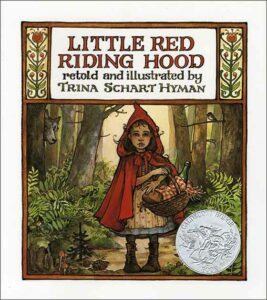
Little Red Riding Hood
by Trina Schart Hyman
28 pages
Gorgeous artwork makes this the very best version, but parents should know Little Red gets eaten in this one, before finally being rescued. That makes this old-school retelling a bit tough on some kids. But that extra bit of tension can be a good way of introducing a little grit, small in dosage, to stiffen young spines and ready our kids for their task as truth-tellers and dragon-slayers. And kids will love finding the cat that artist Trina Schart Hyman has hidden on every page.
Honoree
Ten, Nine, Eight
by Molly Bang
22 pages
As a youngster is put to bed, readers count down from her ten cute toes, to her nine stuffies, and so on, in this simple but charming counting book.
1983
Honoree
A Chair for My Mother
by Vera B. Williams
30 pages
In what could be a true story, we see how little Rosa’s family recovers from an apartment fire that burns all their things. Family and neighbors help out, giving them odd chairs, a kitchen table, a rug, and more. And then the family saves all their spare quarters, putting them in a big glass jar, to save up to buy a big comfy chair. It’s a sweet story about love and thrift and work. A child might ask why there is no father in this family, or might not, as his absence is never noted.
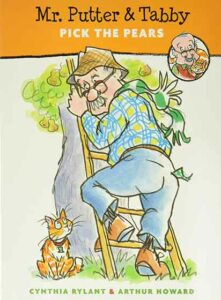 Honoree
Honoree
When I Was Young in the Mountains
by Cynthia Rylant
32 pages
The author of the fantastic 25-book Mr. Putter and Tabby series (seriously, you have to check it out!) shares the story of her own childhood, growing up in the Appalachian mountains with her grandparents. A gentle story, with one oddity being the absence of her parents, which is never touched on.
1981
WINNER
Fables
by Arnold Lobel
42 pages
The author of the Frog and Toad series crafted this collection of 20 one-page fables about all sorts of animals. They all have a moral to their story, most of which might even be true; in “The Hen and the Apple Tree” a chicken learns that the apple tree that shows up in her yard one day, and which has a furry trunk and fuzzy toes, may not be a tree after all. When she tricks the wolf underneath into revealing himself, we are told: “It is always difficult to pose as something that one is not.” A couple of the morals are a tad problematic – one declares “satisfaction will come to those who please themselves,” which seems a little self-absorbed – but so long as a child doesn’t treat this as sacred, but simply silly, this will just be fun.
Honoree
Mice Twice
by Joseph Low
30 pages
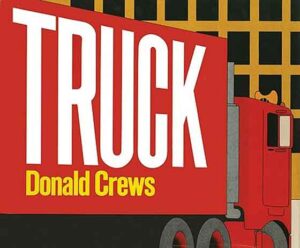 Cat invites Mouse for dinner, and when Mouse asks if he can bring a friend, Cat says yes, thinking that twice the mice will be quite nice. But when Mouse shows up accompanied by Dog, Cat gets more than he bargained for. And that’s only the first dinner invite in this trickster tale.
Cat invites Mouse for dinner, and when Mouse asks if he can bring a friend, Cat says yes, thinking that twice the mice will be quite nice. But when Mouse shows up accompanied by Dog, Cat gets more than he bargained for. And that’s only the first dinner invite in this trickster tale.
Honoree
Truck
by Donald Crews
24 pages
In this wordless brightly-colored gem, we get to follow a red semitrailer truck bring its load of bicycles through all sorts of traffic. Pre-schoolers will love this, because they can, kind of, read it on their own.
1980
WINNER
The Ox-Cart Man
by Donald Hall and Barbara Cooney
40 pages
In 1832 a farmer and his family pack up their ox-cart with all the goods that they are bringing to market. They’ve got wool, goose feathers, brooms, linen, mittens, and more. Market is a 10-day walk and when he gets there, the farmer sells everything, including his ox and ox-cart. Then he uses the money to get tools and treats for his family, and makes his journey back. Told in a poem of sorts (no rhymes but lots of rhythm) and with beautiful pictures, this will give kids a good understanding of all the industry involved in farming way back when.
1979
Honoree
Freight Train
by Donald Crews
24 pages
Just 55 words, but lots of brightly colored train pictures make this a quick, pleasant read for 2-5 year olds.
1978
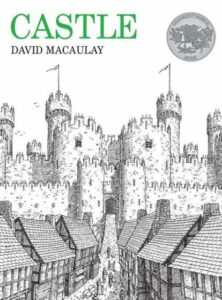 Honoree
Honoree
Castle
by David Macaulay
80 pages
Author David Macaulay tells the detailed, historically accurate (though fictitious) story of how an English castle was constructed in the late 1200s. Be sure to get the 2010 version, which has all the full-page pictures in full color. Castles are the coolest, so if you were to get just one Macaulay book, this should be it.
Honoree
Noah’s Ark
by Peter Spier
48 pages
This is a beautifully illustrated, nearly wordless account, with only three of the 48 pages containing text: two are biblical quotations, and the other is given to an English translation of a 400-year-old poem about the Flood by Dutchman Jacobus Revius. The rest is filled with seemingly simple but incredibly detailed pictures of Noah and his family as they build the Ark, bring in the animal pairs, and feed and care for them inside. Some of the detail is whimsical – a mouse is shown trying to push an elephant’s foot off of its fellow mouse’s tail – but we also see the floodwaters overtaking the animals that were left behind. This is no cutesy, sanitized account! I will add that a friend still thought the pictures a tad too whimsical – that they were making a joke out of things. I disagree, and the only problem I had is one picture where it appears as if Noah (rather than, as the Bible says, God) is closing the Ark doors. But we can choose to assume God is on the other side, sealing them shut.
1977
Honoree
Fish for Supper
by M.B. Goffstein
30 pages
A simple line drawn, simple story about a day in the life of the author’s grandmother, how she would rise early in the morning, make breakfast, fish all day, prepare the fish for dinner, and go to bed. Too simple for Grade 2, but maybe just perfect for Grade 1.
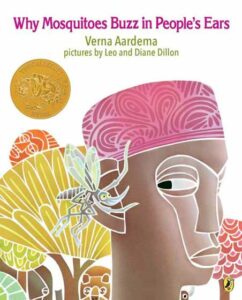 1976
1976
WINNER
Why Mosquitoes Buzz in People’s Ears
by Verna Aardema and Leo and Diane Dillon
32 pages
In this folk tale from West Africa a mosquito annoys an iguana who in his huff, freaks out a snake, who in running away, startles a rabbit, who alarms a crow, who scares a monkey, who in swinging away as rapidly as he can, breaks a branch which lands on an owlet, killing it. The mother owl normally hoots to awake the Sun to start the say, but because she is so very sad now, she won’t hoot. And so the whole forest is cast in darkness. Eventually, King Lion tracks down, one animal after another, who started this chain of events. But was it really the mosquito’s fault? That might be a good point to raise with young readers. This chain of events reminds me a lot of Mike McClintock’s fantastic A Fly Went By.
1974
Honoree
Cathedral
by David Macaulay
80 pages
The one that started it all. Its oversized pages showcase in words and wonderful, detailed pictures how a medieval people, lacking all our modern construction tools, could build something that would marvel us still today. The black and white original was redone in color in 2013, and the added vibrancy is wonderful.
1972
WINNER
One Fine Day
by Nonny Hogrogian
34 pages
A fox drinks up an old woman’s milk, so she cuts off his tail. That’ll have all his friends making fun of him, so he makes a deal that the old woman will give him his tail back if he gives her her milk back. That sends him to go make a deal with a cow, who wants only some grass in return. The field will give him grass if only he brings it some water… and so on and so on. Ten trades later, and he’s got his bushy back end in place again. Great for ages 2-8.
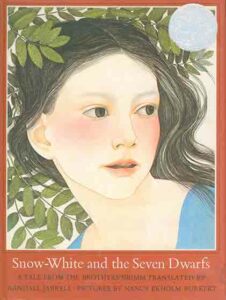 Honoree
Honoree
Snow-White and the Seven Dwarfs
by Randall Jarrell and Nancy Ekholm Burkert
32 pages
The classic tale gets a bit of a “Goldilocks and the 3 Bears” twist, with Snow-White coming upon the dwarfs’ home, sampling all of their meals in turn, and trying out each of their beds before falling asleep on the last. And when the dwarfs arrive home, they do the whole “Who’s been eating out of my little plate?” routine. In this version, the wicked queen has three unsuccessful goes at killing Snow-White (first she eats what she thinks is Snow-White’s lung and liver!) before seeming to accomplish her aims with the fourth go. It is Snow-White with a harder edge, but one that is more in keeping with the original. Best read with an adult, I would think. Wanda Gág’s Snow White and the Seven Dwarfs, a 1939 Caldecott Honoree, tells the same tale – almost identical text – but with its own charming art.
1971
Honoree
Frog and Toad Are Friends
by Arnold Lobel
64 pages
This is but one in a series of Frog and Toad books, all of which contain a number of stories about these two good friends. Most are gentle, but I will say, some are better than others. The oddity in this collection of five is “A Swim” where Toad and Frog going swimming. Frog, normally clothed, just takes off his clothes to dive in. That’s sort of weird, because people wouldn’t do that, and these critters are sort of stand-in people. Making it odder still is that Toad does have a swimsuit. But one he feels shy about. And in the end, Frog and several animals laugh at him. So, not so nice either. More typical is story #3, where Toad is sad because no one ever sends him mail. So, of course, Frog sends him a letter but relays it via a snail. So they both have to wait a long long time for the letter. That’s the sort of gentle fun that’s made so many like Frog and Toad. Two other books in the series are better, with nary a sour note: Frog and Toad Together and Frog and Toad All Year.
1970
WINNER
Sylvester and the Magic Pebble
by William Steig
34 pages
Sylvester, a donkey child, comes across a magic pebble and runs home to tell his family. But on the way back, he bumps into a lion, and instead of using the pebble to transform the lion into something like a bug, Sylvester’s first thought is, “I wish I was a rock.” He’s saved from the lion, but now the magic pebble is lying next to him and he can’t pick it up. A happy ending accompanies the message that, really, what more could Sylvester wish for than to be with this family? I’ll put a plug here for another Steig title that didn’t win the Caldecott but which makes a wonderful argument for the self-evident truth we have of a Creator: Yellow & Pink.
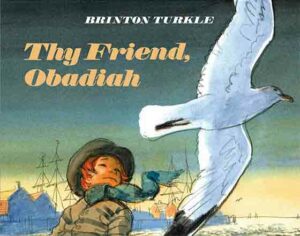 Honoree
Honoree
Thy Friend, Obadiah
by Brinton Turkle
38 pages
Why is this seagull following Obadiah wherever he goes? The little boy doesn’t like it, though his parents think it quite special that one of God’s creatures would favor him like this. After chasing it off, Obadiah starts to miss it. And thankfully, he gets a second chance to befriend the bird who first befriended him. This takes place in early 1800s Nantucket. It’s a thoroughly charming book, made all the more so by the quaint way the Quaker mom and dad talk (but not Obadiah) with “thees” and “thous.” In an equally delightful sequel, Rachel and Obadiah, Obadiah and his sister learn that when a ship returns safely, a child can earn a silver coin by running to the captain’s wife to give her the news. But which of them will get the job? To figure it out, they race. Obadiah is bigger and consequently faster, but in a Turtle and the Hare fashion, he lets something – a bush of blackberries! – distract him, and Rachel wins the race and the job. This was a sweet treat!
1968
WINNER
Drummer Hoff
by Barbara and Ed Emberley
32 pages
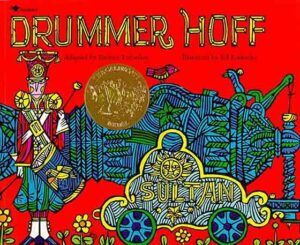 A silly, brightly-colored book about a troop of soldiers all coming together to create a cannon and fire it… once. A sample of the fun rhymes: “Sergeant Chowder brought the powder, Corporal Farrell brought the barrel, Private Parriage brought the carriage, but Drummer Hoff fired it off.” A delightful read-out-loud, but so very short, that might be a reason to borrow, rather than buy it.
A silly, brightly-colored book about a troop of soldiers all coming together to create a cannon and fire it… once. A sample of the fun rhymes: “Sergeant Chowder brought the powder, Corporal Farrell brought the barrel, Private Parriage brought the carriage, but Drummer Hoff fired it off.” A delightful read-out-loud, but so very short, that might be a reason to borrow, rather than buy it.
1966
WINNER
Always Room for One More
by Sorche Nic Leodhas and Nonny Hogrogian
32 pages
A wonderful old Scottish poem about a man and his wife who always had room for one more in their house…. until they pushed that to its limits and the house exploded! But don’t worry, there is a happy ending for this generous family. Best read by an adult, as there are a few old-fashioned words (like “bairns”) that kids will figure out when they hear it, but not as easily when they read it. A very fun one for kids 3 through 9.
Honoree
Hide and Seek Fog
by Alvin Tresselt and Roger Duvoisin
32 pages
When a 3-day fog rolls in on this coastal town, everyone – fishermen, vacationing families, and even the drivers – have to slow down and wait it out. Soft pastel-ish pictures obscure details and give kids the impression of fog. Nicely done. Good read for kids 4-8 and kids in Grade One will enjoy reading it to themselves.
1965
Honoree
A Pocketful of Crickets
by Rebecca Caudill and Evaline Ness
48 pages
A longer picture book sharing a little boy’s friendship with the cricket he found and brought to school. The pacing is leisurely, and there’s nothing scary, making this a good bedtime tale, though I suspect some boys could find it too slow.
1964
Honoree
Swimmy
by Leo Lionni
32 pages
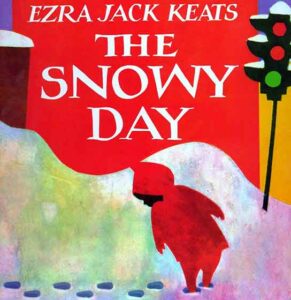 If the animals in fairy tales were actual people, some of these stories would be downright brutal – just think of The 3 Little Pigs, or The Ugly Duckling for example. But they aren’t people, and that makes the horrific more distant and palatable, as happens here, where the story begins with everyone Swimmy knows getting eaten, in just one gulp, by a “swift, fierce, and very hungry” tuna. Thankfully, Swimmy’s life takes an upturn from there as he travels the ocean, seeing wonderful sights. And when he finds another school of fish, he now knows how to protect them, getting the whole bunch of them to swim in tight formation so together they look like a big fish and scare away the predators. Clever, and with some intriguing art.
If the animals in fairy tales were actual people, some of these stories would be downright brutal – just think of The 3 Little Pigs, or The Ugly Duckling for example. But they aren’t people, and that makes the horrific more distant and palatable, as happens here, where the story begins with everyone Swimmy knows getting eaten, in just one gulp, by a “swift, fierce, and very hungry” tuna. Thankfully, Swimmy’s life takes an upturn from there as he travels the ocean, seeing wonderful sights. And when he finds another school of fish, he now knows how to protect them, getting the whole bunch of them to swim in tight formation so together they look like a big fish and scare away the predators. Clever, and with some intriguing art.
1963
WINNER
The Snowy Day
by Ezra Jack Keats
40 pages
Simple story about a little boy who discovers it has snowed overnight. We get to follow along as he crunch, crunch, crunches through the snow, drags a stick to make trails in the snow, and makes snow angels. And after a good long day of exploring the snowfall, his mom helps him out of his wet clothes as he tells her about his adventures. A relatable story for any kid who’s been excited about a snowfall. Recommended for ages 2 or 3 through 1st Grade. The 50th-anniversary edition is worth hunting down, for the extra pages that explain the history of the book, and the impact of its black central figure at a time when black children weren’t seen in children’s stories.
1962
Honoree
Little Bear’s Visit
by Else Holmelund Minarik
64 pages
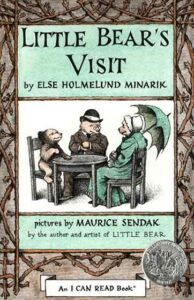 When Little Bear visits his grandparents both of them have a story to share, grandma sharing about what Little Bear’s mom was like when she was little, and grandpa sharing, well, a bit of a dad joke. Pictures on every second page, and a decent length at 64 pages, make this a wonderful 10-15 minute read for grandma and grandpa to share with their own little cubs. This is #4 in a series of 6, and Little Bear (the first), Father Bear Comes Home, Little Bear’s Friend, and Little Bear and the Marco Polo were quite nice as well. There is one last title, but Hen, a character in A Kiss for Little Bear, thinks this book has “Too much kissing!” and I would agree.
When Little Bear visits his grandparents both of them have a story to share, grandma sharing about what Little Bear’s mom was like when she was little, and grandpa sharing, well, a bit of a dad joke. Pictures on every second page, and a decent length at 64 pages, make this a wonderful 10-15 minute read for grandma and grandpa to share with their own little cubs. This is #4 in a series of 6, and Little Bear (the first), Father Bear Comes Home, Little Bear’s Friend, and Little Bear and the Marco Polo were quite nice as well. There is one last title, but Hen, a character in A Kiss for Little Bear, thinks this book has “Too much kissing!” and I would agree.
1961
Honoree
Inch by inch
by Leo Lionni
32 pages
The inchworm is proud of how he can measure just about anything with his inch-long body. But then the nightingale issues him an impossible challenge: “Measure my song or I’ll eat you for breakfast.” Can he do it? Well, no. But kids will enjoy how the inchworm gets himself out of this predicament, and find it a fun challenge to spot him on the closing pages. Good for preschoolers through Grade One.
1959
WINNER
Umbrella
by Taro Yashima
30 pages
When a three-year-old is given rain boots and an umbrella for her birthday, she can’t wait for it to rain. But wait she must, as an Indian Summer has everything dry and breezy. Maybe she could use it to shade her eyes from the sun? Nope, mamma says wait for the rain. And eventually, the rain comes, and this little girl becomes a big girl, holding an umbrella just like a grown-up lady!
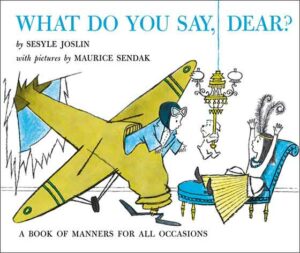 Honoree
Honoree
What Do You Say, Dear?
by Sesyle Joslin and Maurice Sendak
48 pages
The subtitle sums it up: “A book of manners for all occasions.” So, if a child doesn’t know quite what to say when a gentleman is giving away baby elephants, and the child would really like one, but first they need to be introduced, and he doesn’t know quite what to say, help is to be had here (the child should say “How do you do?”). If you bump into a crocodile when walking backward? You should say, “Excuse me.” And if a cowboy outlaw asks, “Would you like me to shoot a hole in your head?” we are informed that the polite thing to say is, “No, thank you.” This last one would understandably put some parents off, so this isn’t one for a Christian school library, but could be a fun, silly one to borrow and read with your kids!
1958
WINNER
Time of Wonder
by Robert McCloskey
64 pages
An almost poetic account of a family spending their summer on the Atlantic coast. Lots of beautiful coastal pictures. An enormous storm brings this otherwise quiet story a needed bit of action.
Honoree
Anatole and the Cat
by Eve Titus and Paul Galdone
32 pages
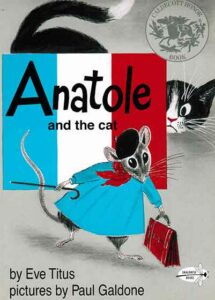 Anatole is the most honored muse in all of France, in charge of all the cheese tasting at M’sieu Duval’s factory. He ensures only the tastiest of cheeses are sent out to the customers. But no one – not even M’sieu Duval himself – knows that Anatole is a mouse. He does all his work at night when everyone else has gone to sleep and leaves notes for the workmen to read. As well as this system normally works, when a cat shows up in the factory, things go all higgly piggly, with Anatole so flustered he leaves nonsense notes for the workmen, telling them to wrap the cheese in banana peels, or add chocolate ice cream. Fortunately, Anatole is very clever, so with a lot of thought, and some bravery, he faces the cat, and bells it, so it will never be able to sneak up on him again. This is a longer book, that only Grade 2 and up will be able to read on their own, but kids 5 and up will really enjoy hearing. This is one of my favorites on this list. There are many other Anatole stories including one more on this list, the original Anatole, a 1957 Caldecott honoree. I’ve read and enjoyed four others: Anatole over Paris, Anatole in Italy, Anatole and the Piano, and Anatole and the Toyshop.
Anatole is the most honored muse in all of France, in charge of all the cheese tasting at M’sieu Duval’s factory. He ensures only the tastiest of cheeses are sent out to the customers. But no one – not even M’sieu Duval himself – knows that Anatole is a mouse. He does all his work at night when everyone else has gone to sleep and leaves notes for the workmen to read. As well as this system normally works, when a cat shows up in the factory, things go all higgly piggly, with Anatole so flustered he leaves nonsense notes for the workmen, telling them to wrap the cheese in banana peels, or add chocolate ice cream. Fortunately, Anatole is very clever, so with a lot of thought, and some bravery, he faces the cat, and bells it, so it will never be able to sneak up on him again. This is a longer book, that only Grade 2 and up will be able to read on their own, but kids 5 and up will really enjoy hearing. This is one of my favorites on this list. There are many other Anatole stories including one more on this list, the original Anatole, a 1957 Caldecott honoree. I’ve read and enjoyed four others: Anatole over Paris, Anatole in Italy, Anatole and the Piano, and Anatole and the Toyshop.
Honoree
Fly High, Fly Low
by Don Freeman
54 pages
Sid, a pigeon, and Midge, a dove, made their nest in the B of a lit-up sign in the city of San Francisco. The B sheltered them from the rain, and warmed them too. But when workers take down the sign, Sid doesn’t know where his nest, Midge, or their two eggs have gone. Thankfully, a bird-loving older man is happy to help. Lots of color on these pages, and a longer than average story make this a wonderful read for ages 5 to 8.
1957
WINNER
A Tree is Nice
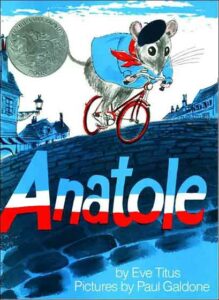 by Janice May Udry and Marc Simont
by Janice May Udry and Marc Simont
32 pages
Trees are nice for dozens of reasons, as recounted one after another here. This would be a great book to share with children to have them understand just how blessed they are, by taking something they most often overlook – something like a tree – and showing how many ways just this one thing improves their lives. To be clear, this isn’t a Christian book, but it sure is a great book for a Christian parent to use in instructing a little one.
Honoree
Anatole
by Eve Titus and Paul Galdone
32 pages
A mouse wants to make an honest living instead of just living off what he can snitch from humans. So he heads out to a Parisian cheese factory to see if he can put his cheese expertise to profitable use. Remarkably he gets hired by the factory owner… though the owner never discovers he is a mouse! Fun, clever, and long enough for a good bedtime read for ages 5 and up.
Honoree
Gillespie and the Guards
by Benjamin Elkin and James Daugherty
58 pages
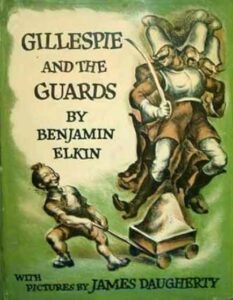 This one is not widely available, but worth a laugh if you can find it. Three brothers have the sharpest eyes on the planet so the king makes them his guards and challenges his kingdom to try and pull one over on them. When no one can, the guards grow proud. That’s when little Gillespie decides to trick them, for their own good. Each day he takes a wagon load of worthless things from the palace – leaves, sand, garbage, etc. – and each day the guards inspect his load to make sure he’s not taking anything valuable. After weeks of this, the little boy calls the king to show him the trick he’s pulled on the guards. So off they go, a whole parade of royals and guards and even a band to the boy’s garage where he shows them…. dozens and dozens of wagons!
This one is not widely available, but worth a laugh if you can find it. Three brothers have the sharpest eyes on the planet so the king makes them his guards and challenges his kingdom to try and pull one over on them. When no one can, the guards grow proud. That’s when little Gillespie decides to trick them, for their own good. Each day he takes a wagon load of worthless things from the palace – leaves, sand, garbage, etc. – and each day the guards inspect his load to make sure he’s not taking anything valuable. After weeks of this, the little boy calls the king to show him the trick he’s pulled on the guards. So off they go, a whole parade of royals and guards and even a band to the boy’s garage where he shows them…. dozens and dozens of wagons!
1956
WINNER
Frog went a-courtin’
by John Langstaff and Feodor Rojankovsky
32 pages
An old folk tale about a Frog courtin’ Miss Mousie, and having to get Uncle Rat’s permission. Then we get introduced to many wedding guests, including “a bumblebee…banjo buckled to his knee,” and “two little ants, fixin’ ’round to have a dance.” It’s all done in rhyme, and the ambitious parent can have a second go at it with the tune written up in the back. Charming, and good for ages 2 through 8.
Honoree
Play with Me
by Marie Hall Ets
26 pages
When a little girl asks a frog, a turtle, a bird, and even a snake to “play with me” the animals all hop, swim, fly, or slither away instead. But when she, in disappointment, sits down and sits still, they all come back around to her delight. I don’t know how this won an illustration award but the sweet story will please toddlers and other preschoolers.
Honoree
Crow Boy
by Taro Yashima
38 pages
On the first day of school a boy is so shy they find him hiding “in the dark space underneath the schoolhouse.” He finds school boring, and the children start calling him “stupid and slowpoke.” But, day after day, he shows up for class. And things change when a new teacher arrives and discovers that this little boy knows quite a lot about the world outside the classroom – the plants, and especially the crows! He is so good at imitating crow calls, that the insults thrown his way are replaced with a more affectionate nickname, “Crow boy.” The boy’s schoolmates then discover that the boy has been walking to school each day, starting at dawn to get there – and he has never missed a day! His classmates and his whole school start to understand that their little crow boy is quite the exceptional student. Set in Japan, this tale of trouble, and finally acceptance, could get a few tears going for Grade One and Two.
1955
WINNER
Cinderella, or the Little Glass Slipper
by Marcia Brown
32 pages
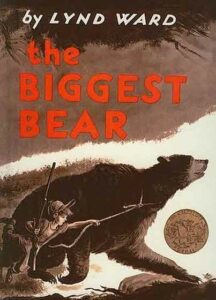 The classic tale, well told. Cinderella even looks out for her step-sisters, finding them handsome lords to marry. After you acquaint your children with the original, you’ll want to share the classic retold: Shirley Hughes’ Ella’s Big Chance.
The classic tale, well told. Cinderella even looks out for her step-sisters, finding them handsome lords to marry. After you acquaint your children with the original, you’ll want to share the classic retold: Shirley Hughes’ Ella’s Big Chance.
1953
WINNER
The Biggest Bear
by Lynd Ward
88 pages
Little Johnny goes out into the woods to shoot himself a bear, but comes back home with a baby bear. That baby grows and grows, eating not only Johnny’s family’s food but their neighbors’ food too, necessitating that Johnny take his friend back into the woods. But as far as Johnny takes him, the bear always returns. And this is where the book goes a little old school, telling a story I don’t know that you would find in any kids’ picture book today: Johnny and his dad conclude a different solution is needed. Parents will quickly figure out what that solution is – Johnny is going to take the bear into the woods to shoot him! – but kids may not, as it isn’t ever stated that plainly. And before Johnny can shoot the bear, they both get trapped in a cage put out by zoo folk looking for a new exhibit. A happy ending for everyone!
1952
WINNER
Finders Keepers
by William Lipkind and Nicolas Mordvinoff
32 pages
Two dog buddies argue over who should get the bone they discovered. They ask a farmer, a goat, and a barber, none of whom offers much help. Only when another dog tries to steal the bone do the two friends realize sharing something is better than having nothing.
1951
Honoree
Dick Whittington and His Cat
by Marcia Brown
36 pages
In feudal times a young orphan boy constantly struggles to fill his belly. When finally he finds a household he can serve in, the cook beats him and rats and mice keep him up all night. Fortunately, he is able to buy a cat that makes short work of this second problem. Then, when his master sends out goods to trade around the world, Dick sends his only possession, his cat, along. When the tradesman later come across a Barbary King who is also plagued by mice, the king buys the cat for a chest of jewels. And the young Dick Whittington gets quite the happy ending!
1950
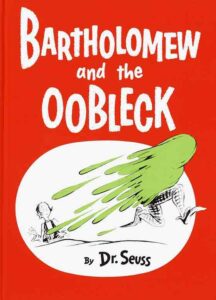 Honoree
Honoree
Bartholomew and the Oobleck
by Dr. Seuss
54 pages
A king isn’t satisfied with just the regular old snow, fog, sunshine, and rain coming down from the sky – he thinks he’s so important that he should be able to get something new! So, despite the advice of his loyal manservant Bartholomew, the king calls up his royal magicians. They promise to make him “oobleck.” What is it? They don’t know because they’ve never made it before. But as Bartholomew warns the king, this sticky, icky stuff isn’t a step up from the snow, fog, sunshine, and rain! A fun, goofy story about humility.
Honoree
The Happy Day
by Ruth Krauss and Marc Simont
32 pages
The Caldecott committee must have had a thing for snow, because here’s another that’s filled with page after page of the white stuff. In the opening pages we’re shown scenes of bears sleeping, and mice sleeping, and even snails sleeping. But then they start sniffing, one after the other. And then they all start running! They sniff and run, run and sniff. Why? Well, because they’ve all caught the scent of… spring’s first flower! So maybe this isn’t so much about snow, as it is a celebration of coming spring!
1949
WINNER
The Big Snow
by Berta and Elmer Hader
48 pages
When the geese head south for the winter, all the other animals in the forest choose their own path. The groundhog, Mrs. Chipmunk, the skunk family, and the raccoons get ready to hibernate. Meanwhile, Mrs. Conttontail and her little rabbit, two cardinals, three black crows, and the deer, are preparing themselves to live through the snowy weather ahead. And some others are going to leave with the geese, including a blue jay, and a bluebird. It’s a highly educational story, teaching which animals do what, and at the end it notes how an old man and old woman help the animals through the winter by spreading seed and hay on the ground after a heavy snowfall – some stewardship over creation shown right there! There are a fair amount of words, so it might be a bit much for the youngest children. Recommended for 5 through Grade 2.
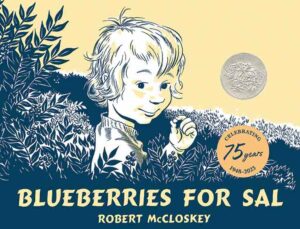 Honoree
Honoree
Blueberries for Sal
by Robert McCloskey
64 pages
Little Sal and her mother go berry picking in the same patch as a mother bear and little bear go berry eating. The two mothers’ young’uns get switched for a time, and quiet hilarity ensues.
Honoree
Fish in the Air
by Kurt Wiese
64 pages
A Chinese boy by the name of Fish, asks his father, Big Fish, for the biggest kite that looks like a fish. When they get it, a gust of wind picks up the kite and the boy, and sails them out over the river where a Fish Hawk destroys the kite. The boy lands in the river and is retrieved by a fisherman. The book ends with the boy asking his father for the smallest kite that looks like a fish – a nice punchline. The one caution about the book is that it is a pre-industrial setting (probably decades before the book was written) and that is nowhere noted, so kids could read this and perhaps think this is how China is now.
1948
WINNER
White Snow Bright Snow
by Alvin Tresselt and Roger Duvoisin
30 pages
Everyone knows it is going to snow, so when it does, the postman, policeman, and farmer are ready… and the children are delighted. When the snow goes the next day, the adults are quite happy, and the kids look forward to Spring. Part poetry and part prose, this might be a bit slow for some children, but it would be great for a unit on snow, as would the other half dozen books on snow in this list.
Honoree
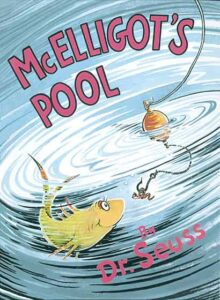 McElligot’s Pool
McElligot’s Pool
by Dr. Seuss
60 pages
A boy is told he’s “sort of a fool” for fishing in the tiny junk-filled McElligot’s Pool. But the boy wonders if it might not be connected, down below, to an underground stream that maybe even goes to the sea. And then who can imagine but what sorts of fish he might catch. In typical Seuss-style, the boy imagines all sorts of never-before-seen sea creatures, from cow-fish and dog-fish to something that makes whales look like sardines.
1947
Honoree
Rain Drop Splash
by Alvin Tresselt and Leonard Weisgard
30 pages
What starts as just a “drip drop splash” bit of rain that “dropped from a rabbit’s nose” and “splashed from a brown bear’s tail” eventually flows into a puddle, and then a brook, and a river and finally the sea, showing us one half of the water cycle. It’s a lyrical look, with scenes of wherever the water flows. Great book for early readers in Grade One.
Honoree
The Boats on the River
by Marjorie Flack and Jay Hyde Barnum
30 pages
We’re introduced to all sorts of boats: a Ferryboat, paddle-wheel Riverboat, Ocean Liner, Tugboat, Motorboat, Sailboat, Rowboat, Freightboat, Submarine, and, finally, American Warship. It’s a 70-year-old book, so some of these boats have gotten bigger since then, but it’s still quite the charming introduction. A good Grade One read.
1946
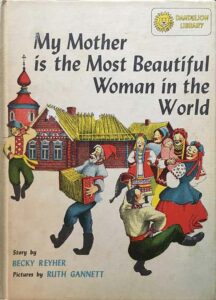 Honoree
Honoree
My Mother is the Most Beautiful Woman in the World
by Becky Reyher and Ruth Stiles Gannett
46 pages
Varya is a little Ukranian girl who, like all the children of the village, helps her parents with the wheat harvest. Of course, she doesn’t work quite as hard as them, and when she takes a break in the middle of the wheat, she finds herself lost. Surely she can find the harvesters, she can hear them just over there. But it turns out, those are strangers, and she gets quite distraught. The strangers are harvesting their own wheat, but eager to help reunite lost little girl and momma, so they ask Varya if she can tell them who her momma is. The girl, fighting tears, can only blurt out, “My mother is the most beautiful woman in the world!” The leader laughs and says, “Now we have something to go on” and calls all the local beauties to see which of them it might be. But no, it is none of them. Just then Varya’s mother shows up, and we learn while she might not be so beautiful by the standards of the world, loving someone makes them beautiful to you. This got me a little misty, thinking of how God’s love makes us beautiful. This is a wonderful, longer picture book that would be best shared by mom or dad or a teacher so they can explain why it is that this 1945 book interchanges the terms Ukrainian and Russian as being synonymous with each other.
Honoree
Little Lost Lamb
by Golden MacDonald and Leonard Weisgard
44 pages
When a black sheep decides to head off on his own, the little shepherd heads into the dangerous nighttime mountains to find him and bring him back. A good one for five and under, and could be accompanied by a reading of Psalm 23.
Honoree
You Can Write Chinese
by Kurt Wiese
66 pages
I remember coming across the Braille alphabet as a child, and the Morse code, and being fascinated. So while this won’t be interesting for every child, some might be intrigued to accompany an American boy as he is taught the Chinese characters for numbers and some familiar objects. Any reader will come away with an appreciation for how our alphabet system of writing sure is an upgrade!
1945
Honoree
In the Forest
by Marie Hall Ets
40 pages
During his walking in the forest, a boy comes across a lion, two baby elephants, a couple of bears eating jam and peanuts, and a stork who was so still the boy had to walk right up to him to find out if he was real. More animals join the parade, and they play Hide and Seek, which ends when the boy’s father comes hunting for him. Was it all just pretend? Yes indeed, and they’ll all be waiting for the little boy when he comes back again tomorrow.
Honoree
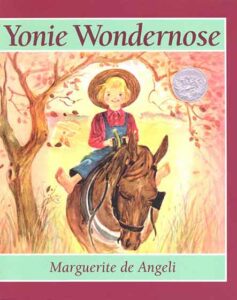 Yonie Wondernose
Yonie Wondernose
by Marguerite de Angeli
44 pages
This has been described as an Amish Curious George tale. Yonie is a seven-year-old Pennsylvania Dutch boy whose father is trusting him to take care of the farm while he is away. But that’s a hard task for a boy who is always wondering about where that squirrel just disappeared to, or what caused that noise over there. Yonie is so curious he almost can’t help but be constantly distracted from all the work he has to do. But he’s trying! And when lightning sets the barn on fire, Yonie has to focus, to get all the animals out safely, and even then, he has a hard time of it! But there is a happy conclusion. The drawings are old-fashioned, and the Amish setting only adds to that. But the story is great. So, I think kids will love this, so long as it is read to them.
1944
Honoree
Pierre Pidgeon
by Lee Kingman and Arnold Edwin Bare
50 pages
In this Canadian tale, a boy in a fishing village on the East Coast knows just what he wants for his birthday: that ship in a bottle at the corner store. Pierre makes his own ship models, but they aren’t in bottles. How did this big ship get past the small opening, into the bottle? Pierre gets his wish, and uses birthday money to buy the boat. But on the way home an energetic dog jumping all over him causes Pierre to drop the bottle. That makes him sad, but sets him on the path to figuring out how to get his ship into a new bottle.
1943
WINNER
The Little House
by Virginia Lee Burton
44 pages
The story starts with a solid little house in the country that can just see the lights of the city on the horizon at night. But as the decades pass, the city approaches and then engulfs the little house, making her sad. But when the first owner’s great-great-granddaughter comes across it, she decides to move the solid little house to a new spot, out in the country once more.
Honoree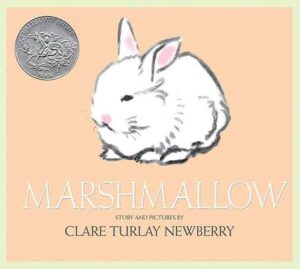
Marshmallow
by Clare Turlay Newberry
36 pages
What a delight! Anyone who loves bunnies or cats is going to adore this book. The illustrations are wondrous – you can tell what the cat is thinking just from how its eyes and ears are drawn. Oliver is a house cat who’s never even met other animals, and just generally likes his sedentary ways. So when a baby bunny moves into the premises, Oliver is more than a little freaked out. And that stops him from being the friend that the little baby bunny Marshmallow really needs right then. Afterward, as they hang out more, Oliver goes from scared to… well, predatory. Cats will be cats, after all. But their smart owner heads things off before trouble starts. And this talented lady also writes a couple of charming poems in tribute to her newest pet. So will Oliver and Marshmallow every become best buds? Well, yes, and super cute buddies they will be! This is just such a charming and quietly quirky treat.
1942
WINNER
Make Way for Ducklings
by Robert McCloskey
72 pages
Mr. and Mrs. Mallard want to find a good place to settle down. A city park would have been ideal – passersby fed them peanuts! – but the kids on bicycles were just too fast. That wasn’t a good place to raise ducklings. Finally they settle on an island in the nearby river, and befriend a nearby police officer who has peanuts to share. And when the whole family wants to go for a walk to that city park? Well, their police officer friend is happy to stop traffic for them! Wonderful drawings and 72 pages of space give the author enough time to tell a simple story wonderfully.
1941
Honoree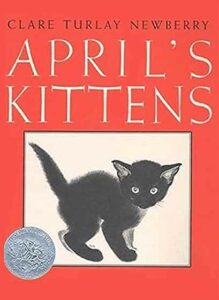
April’s Kittens
by Clare Turlay Newberry
34 pages
Newberry sure knows cats: how to draw them, and what a treat they are to those that love them. April and her mom and dad and their cat Sheba live in New York in an apartment so small that though she is six, April still sleeps in her crib. There just isn’t room for a bed. That also means, as her father often says, that it is just a one-cat apartment. So when Sheba gets pregnant and delivers three kittens, father is clear: three of them have to go. And if April wants to keep a kitten, then Sheba will have to go! There’s some real tension in this one, as April is so sad at the thought of Sheba leaving. But when her mother and father realize April has outgrown her crib, they make plans to find a bigger apartment so they can fit in a bed for her. And not just that: their new accommodations will be a two-cat apartment; April will be able to keep Sheba and a kitten!
1940
Honoree
Cock-a-Doodle Doo
by Berta and Elmer Hader
54 pages
The moment Red Chick is born it is clear he is not like his fellow hatchlings – they are ducks and he is not! So, he soon sets out into the broader world to find his family, and encounters a hawk and fox who want to eat him. There is a happy ending, but there is genuine peril and it requires a little grit on Red Chick’s part to make it through. This, then, is a classic that’s still worth reading today.
1939
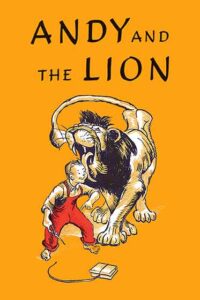 Honoree
Honoree
Andy and the Lion
by James Daugherty
72 pages
After checking out a library book on lions, Andy meets an actual lion! Like Androcles and the Lion (or Jerry Pinkney’s 2010 Caldecott winner The Lion and the Mouse further up this list), Andy makes peace with the lion by pulling a thorn out of its paw. When they next meet, Andy manages to calm the savage beast because it remembers the good deed that Andy did for him.
Honoree
Snow White and the Seven Dwarfs
by Wanda Gág
44 pages
This is a fun retelling of the classic tale, using almost identical text to Randall Jarrell and Nancy Ekholm Burkert’s 1972 Caldecott Honoree, Snow-White and the Seven Dwarfs. While that 1972 account is the more beautiful version, the art here is charming, too, and it could be fun to contrast and compare the two books’ styles.
Honoree
Barkis
by Clare Turlay Newberry
34 pages
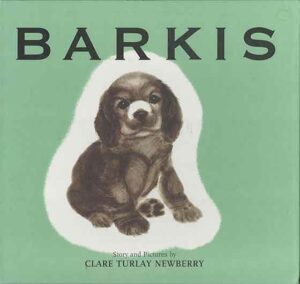 When James gets a puppy named Barkis for his birthday, he won’t share it with his sister Nell Jean. Why? Well, when she got a kitten, she wasn’t so generous either, so now he’s going to do to her, what she did to him. In return, Nell Jean decides she going to hate puppies. When she sees Barkis escape the house, she says nothing, only coming to her senses when Barkis falls into the creek. Then, after she saves the pup, her brother is willing to share Barkis. Before she takes her brother up on his offer, she has to make a confession. Old-fashioned morals and heart-warming pup and kitten pictures make this a treasure still. And while the Golden Rule (Matt. 7:12) isn’t directly cited, the story here sure could be used by parents to speak to it.
When James gets a puppy named Barkis for his birthday, he won’t share it with his sister Nell Jean. Why? Well, when she got a kitten, she wasn’t so generous either, so now he’s going to do to her, what she did to him. In return, Nell Jean decides she going to hate puppies. When she sees Barkis escape the house, she says nothing, only coming to her senses when Barkis falls into the creek. Then, after she saves the pup, her brother is willing to share Barkis. Before she takes her brother up on his offer, she has to make a confession. Old-fashioned morals and heart-warming pup and kitten pictures make this a treasure still. And while the Golden Rule (Matt. 7:12) isn’t directly cited, the story here sure could be used by parents to speak to it.
Honoree
Wee Gillis
by Munro Leaf and Robert Lawson
72 pages
Wee Gillis is a lad of two worlds: his father’s relations are all Scottish Highlanders, and his mother’s are all Lowlanders. So what should he be? Should he tend the cows, calling them home each night as the Lowlanders do? Or should he stealthily stalk stags, like a Highlander will? To figure it out, Wee Gillis spends a year doing each. And, it turns out, his time both high and low prepares him for his true calling: to play the bagpipes like no one else can! A cute tale that kids will enjoy reading to themselves in Grade 1 and 2.
1938
Honoree
Seven Simeons: A Russian Tale and the Lion
by Boris Artzybasheff
32 pages
A rich, powerful, wise, and really really good-looking king wants to find a really good-looking wife. So, like many a fairytale, this has its shallow moments. But it’s also very fun, with classic-styled illustrations that are full of detail. The King recruits the help of 7 brothers, each of whom has his own special talent – one can build super-fast boats, another can see around the world, and a third can steal anything – that sort of thing (for another of this style, check out Claire Huchet Bishop’s Five Chinese Brothers). The whole stealing away of his bride becomes less problematic when the King presents her the choice of marrying him or not. This is a longer read with full pages of text on every second page, which makes it best suited for Grade 2 and up.
TAKE IT OR LEAVE IT (17)
Up next are 17 books that might be worth a read for some, but for a variety of reasons – whether they’re outdated, odd, confusing, or a bit boring – they didn’t make the recommended list. I’ve focused here only on the Caldecott Medal Winners, since those are the most commonly touted and widely available. I thought parents would appreciate a complete accounting of all the Winners, to celebrate the best of them, but also warn parents about the weird ones.
There are some good ones below, but they might need to be put to a particular purpose.
2015
The Adventures of Beekle the Unimaginary Friend
by Dan Santat
36 pages
An imaginary friend who has yet to be imagined gets tired of waiting for his human to think of him, and sails out to the real world in search of her. Whimsical. But for young readers in need of a real friend, this points them in an unhelpful direction.
2009
The House in the Night
by Susan Marie Swanson and Beth Krommes
40 pages
Pictures of black, white, and a little yellow are visually striking, but there’s no discernible story other than, perhaps, that a child is slowly being put to bed. Had a bit of a Goodnight Moon vibe to me. Might work as a quiet good-night read to a child, 5 and under.
2007
Flotsam
by David Wiesner
40 pages
When a boy discovers an old-style underwater camera washed up on the beach, he brings the film in to be developed. There he discovers pictures, seemingly taken by underwater creatures themselves, and the world that they live in when we aren’t looking is certainly something to behold: little mermaids and mermen, robotic fish, giant turtles carrying shell cities on their backs, and even what looks like aliens taking rides on the guppies. Done without any text at all, each picture is another discovery. The very last snapshot is of a girl holding up a picture. And in that picture is a boy holding a picture of a girl holding a picture of a boy. A look through a magnifying picture shows this goes deeper still, and further back in time. The boy’s microscope reveals still more layers to the photo. This is inventive and fun, with the only cautions being that the young target audience may have to be informed that though the photos look quite realistic, the aliens and mermen are fantasy, not fact.
2001
So You Want to Be President?
by Judith St. George and David Small
54 pages
A partisan-free overview of what it’s like to be president, focusing mostly on the trivial, like what pets past presidents had, what they ate, what jobs they had, and more. It’s in this section because minor points are now outdated (even in the updated 2004 edition), like listing Ronald Reagan as the oldest president (Joe Biden is now, by 3 years and counting), and saying no one of color has been president.
1998
Rapunzel
by Paul O. Zelensky
48 pages
A beautiful illustrated version of this well-known fairytale. But like many a fairytale, there are adult themes. The girl Rapunzel is locked up in a tower visited only by the evil witch that put her there. With no door in the tower the witch gains entrance by having Rapunzel let down her long hair, and climbing up. When a handsome prince happens upon her, drawn by Rapunzel’s singing, he too climbs up her hair. The two fall in love, though keeping the prince’s visits a secret from the witch. What’s left unsaid is that they have sex. What is said is that the witch discovers the secret visits when Rapunzel starts complaining about how tight her dresss is becoming. The child reader will only discover she was pregnant when, after the witch drives the girl away, we learn that Rapunzel gives birth to twins. So, yes, a classic fairytale, but an odd one, and with an awkward edit.
1982
Jumanji
by Chris Van Allsburg
30 pages
A set of siblings, Peter and Judy, discover a board game called Jumanji and its instructions warn them that once they start playing, the game can’t be stopped. No biggie, you might think, except that in this game, the hazards become real! When one child takes a card that says, “Lion attacks, move back two spaces,” a real-life lion shows up and starts chasing little Peter. The siblings begin the book quite bratty but otherwise this is quite the imaginative tale. For those familiar with the movie, this original is exciting, and not nearly as frantic.
1971
A Story, a Story
by Gail E. Haley
36 pages
An African fable about how Ananse, the Spider man (think Loki – a trickster god) gets the Sky God to share his collection of stories. Before he’ll share them, the Sky God wants Ananse to bring him “Osebo the leopard of-the-terrible-teeth, Mmboro the hornet who-stings-like-fire, and Mmoatia the fairy whom-men-never-see.” Ananse isn’t strong, but manages to trick the leopard, the hornets, and the fairy, and when he gets the Sky God’s stories, he shares them with mankind. While this is a pagan myth, it might be a good one for a unit on other cultures.
1967
Sam, Bangs & Moonshine
by Evaline Ness
48 pages
Sam is a little girl who can’t stop lying. She doesn’t seem to even understand the difference between what’s real and what is, as her father puts it, “moonshine.” One of her tall tales sends her friend Thomas to go search the beach for the pet kangaroo she doesn’t actually have, and the boy nearly drowns. Only then does she see the trouble lying can cause. That could make this a very good story to read and discuss with your child, but there’s also a talking cat in the story that could make this confusing for a child to read on their own. Can Bangs really talk or not? A parent will understand that this too is Sam confusing reality with moonshine, but as Bangs keeps talking even as Sam realizes the kangaroo isn’t real, it does get a mite confusing, even for a parent.
1965
May I Bring a Friend?
by Beatrice Schenk de Regniers and Beni Montresor
40 pages
A little boy brings a new animal every time he visits the king and queen. There’s nothing problematic in this story, but with forced verse accompanied by not particularly attractive pictures, you might borrow it from the library but never buy it.
1962
Once a Mouse…
by Marcia Brown
30 pages
This fable from ancient India has a hermit rescue a mouse that’s being chased by a cat by transforming the mouse into a bigger cat. When this mouse/cat gets chased by a dog, the hermit makes it a bigger dog, and so on. Eventually he turns it into a regal tiger, but then the mouse/tiger becomes proud, and in punishment, the hermit turns it back into a mouse.
1961
Baboushka and the Three Kings
by Ruth Robbins and Nicolas Sidjakov
24 pages
A old Russian woman, a “babooushka,” is just keeping her house tidy when three kings knock on her door and invite her to help them “to find the Child, to offer Him gifts, and to rejoice in His birth.” But she declines. She regrets that, and the next morning sets off after them. She goes door to door asking after the three kings, but never finding them. We learn at book’s end that she is said to resume her search every year, leaving small gifts behind. This is, then, a Russian version of Santa Claus, bringing gifts on Christmas Eve (though Santa is based on Saint Nicholas, who was a real person). That educational value would have ranked the book higher if not for the artwork: one step up from stick men. I can’t imagine a kid picking this up.
1954
Madeline’s Rescue
by Ludwig Bemelmans
64 pages
In a Paris orphanage/school, 12 little girls are cared for by Miss Clavel (some type of nun?). When one of them, Madeline, falls into the river, she is rescued by a dog, and in gratitude, they adopt it, and name it Genevieve. But when the school trustees see the dog, they boot it out, and Madeline vows the dog will get its revenge. That doesn’t happen, and the dog is welcomed back, despite what the trustees have ordered. There is some rebellion against authority going on here that isn’t addressed and so is tacitly endorsed. The rhymes do make this a fun read.
1950
Song of the Swallows
by Leo Politi
30 pages
A boy loves swallows, is sad when they leave for a season, and sings a joyful song when they return. The story celebrates the wonder of swallows, and two people, the boy and an older man, who appreciate that wonder. But it is set in a Roman Catholic mission and since this book is intended for children, I think this somewhat subtle Catholic boosterism is more significant than it would be in a book for older children.
1947
The Little Island
by Margaret Wise Brown and Leonard Weisgard
48 pages
The story of a little island that, about a quarter of the way through, goes from being an it to a who – it starts talking, chatting with a kitten. Weird. And nothing else happens so this is a bit on the dull side.
1946
The Rooster Crows
by Maud and Miska Petersham
62 pages
This is a fun collection of “American rhymes and jingles” that includes lots of old favorites, but with a new twist for some, like Mary having a lamb whose “fleece was black as tar, and everywhere that Mary went, they thought it was a b-a-a-r.” Quite the forced rhyme to make tar rhyme with bear but a version you probably haven’t heard before. But I wonder if kids will want to listen to more than one or two of these nursery rhymes in a row.
1945
Prayer for a Child
by Rachel Field and Elizabeth Orton Jones
30 pages
A little girl offers up her nighttime prayer, asking for blessings for her milk, bread, bed, sleep, toys, shoes, chair, lamp, fire, mother, father, friends, family, and children far and near. Sweet, and while it doesn’t begin with any mention of God, it ends, “for Jesus’ sake. Amen.” However, as a model for prayer, which is what it means to be, the prayer doesn’t offer adoration to God, or request forgiveness from Him.
1944
Many Moons
by James Thurber and Louis Slobodkin
48 pages
When the king’s sick little daughter asks him for the moon, he wants to get it for her. But his Lord High Chamberlain can’t do it. And neither can his Wizard or his Mathematician. But when the King calls on his Court Jester for some comfort, the Court Jester has an idea: why not ask the princess? This is clever, but has that kids-know-better-than-adults angle, which is why it got bumped down to the “Take It or Leave It” category. In a strange irony, if you do get this story, the 1990 version, still by James Thurber, but with art by Marc Simont, is far more attractive than the 1944’s Caldecott-winning version.
DON’T BOTHER (26)
This last section covers the worst of the Caldecott Medal Winners. These are books that have problems, and sometimes that’s because they explicitly mock God in one way or another. It might be taking His Name in vain, or pitching Santa or the Easter Bunny as a stand-in for Him. Others celebrate things we shouldn’t celebrate, like needlessly risking our lives.
Why bother with the “don’t bothers”? Because, as Caldecott Medal Winners, they’re quite likely to be out on display at your local library, maybe when the new Medal Winner is announced each year. Or parents might find them as part of a promoted list online. Since I was reading them anyway, I figured I could offer up a quick mention to help parents sidestep these stinkers. I could have done the Honorees too, but they don’t have nearly the same fame, and I really wasn’t interested in cataloguing all the world’s lousy books, so that’s why I kept my focus here on only the Caldecott Medal Winners.
2025
Chooch Helped
by by Andrea L. Rogers and Rebecca Lee Kunz
48 pages
A Cherokee little boy, Chooch, wants to help with everything… but his big sister doesn’t think he’s much help at all. This is the kind of book that young kids might like, but the repetitious “Chooch helped” refrain might not appeal to parents who have to read it again and again. A feature of the book – the point of it, really – is an introduction to some Cherokee words, and a slice of their culture. But it concludes with a couple of pages of dense text about the Trail of Tears (1831-1838) – when 5 native tribes were forcibly removed from their lands, after gold was discovered, and thousands died. I didn’t like that inclusion in a picture book, which are for kids. Do they really need to know now, at this age, the worst of what humanity can do to each other? Yes, kids do need to known there are “dragons” out there, but a book with a dragon and no dragonslayer is, in my mind, too much for this age.
2024
Big
by Vashti Harrison
When a little girl becomes a big girl quite early on, no one seems able to stop with the comments. The lesson here is that it’s never a good idea to make critical comments about someone’s appearance, especially if it’s not something they can even change. Anyone who is short, or tall, or skinny, or has this type of hair or that type, will be able to empathize, and maybe other kids who read this will learn to empathize too. I would have recommended it, but for one instance of an “OMG” (abbreviated as such, and not spelled out in full).
2021
We Are Water Protectors
by Carole Lindstrom
A young Indigenous girl preaches how it is our sacred duty to protect Mother Earth from the evil black snake (oil pipelines) that will poison everyone’s water.
2020
The Undefeated
by Kwame Alexander and Kadir Nelson
About racism in America, but identifies as a victim Michael Brown, who likely was not.
2017
Radiant Child
by Javaka Steptoe
The story of Jean-Michel Basquiat, a modern graffiti artist who died young from a drug addiction. Sad life told with often ugly art.
2013
This Is Not My Hat
by Jon Klassen
A story about stealing – a small fish steals a big fish’s hat while it’s sleeping, and brags that he’ll get away with it. While he eventually doesn’t, most of the story is just the bragging and his comeuppance is really minimal.
2008
The Invention of Hugo Cabret
by Brian Selznick
Hugo lives in the walls of a Paris train station, out of sight. This is an intriguing and enormous book, with about half of its 500+ pages devoted to sections of full-page but wordless pictures that show, rather than tell what Hugo is up to. But it is marred by one use of God’s Name in vain.
2004
The Man Who Walked Between the Towers
by Mordicai Gerstein
A man is lauded for frivolously risking his life (and the lives of his friends, and those walking below, unaware of the weighty rope above them that was almost dropped) to walk on a tightrope between New York’s Twin Towers back in 1974.
1997
Golem
by David Wisniewski
This is the Jewish myth of a hero, Golem, crafted out of clay to save the persecuted Jews of Prague a thousand years ago. At that time they were being falsely accused of mixing Christian blood with flour to create their matzos, the unleavened flatbread they eat for Passover. This “blood libel” is an accusation that Jews really faced, and feared, for it could turn a mob against them. The mythic Golem was a giant that could stand up for this persecuted people. Golem might be worth studying in older grades, but because it has some Old Testament echoes – a hand of light draws on the wall, and they create Golem from the dust – it strikes me as too odd to want to present to children.
1995
Smoky Night
by Eve Bunting and David Diaz
A children’s book about marauding rioters? This might be a help to children who have had to live through that fearful experience, but for every other child, this is grim reality they don’t need to be acquainted with yet.
1993
Mirette on the High Wire
by Emily Arnold McCully
The story of a girl and her reluctant mentor – it explores the history of, and praises, the risky practice of high-wire walking.
1986
The Polar Express
by Chris Van Allsburg
It’s a Christmas story all about faith, with nothing at all to do with Christ. A little boy has stopped believing in an all-powerful, loving being, and takes a magic train to discover that actually, Santa is real for those who “truly believe.” Bleck.
1983
Shadow
by Marcia Brown
It’s a story about shadows, told in a tribal African setting. I didn’t really understand the story, which is one strike, and it’s got an eerie vibe, which is another mark against a children’s book.
1979
The Girl Who Loved Wild Horses
by Paul Goble
Indigenous girl from long ago lives with her tribe and cares for its horses. When a storm separates her and the horses from the tribe, she ends up preferring horses to people, and, as legend has it, she becomes one. Thus humans are said to have “relatives among the Horse People,” which is a touch of nature worship nonsense our little kids don’t need.
1977
Ashanti to Zulu: African traditions
by Margaret Musgrove
This is an alphabet book with a different African people highlighted for each letter of the alphabet. It’s pretty cool, and I’d recommend it as a resource for older grades… except that older grades don’t read alphabet books. But the mention of polygamy, Islam, and ancestor worship make this more than a bit odd for its intended audience of preschool children.
1975
Arrow to the Sun
by Gerald McDermott
A Pueblo Indian tale about a boy who is shot as an arrow to visit his father the Sun. To prove he is the Sun’s son, the boy has to go through a series of four trials, and the artwork is so chunky that for 7 pages straight it is impossible to know what’s really going on. It is an already strange story told badly.
1974
Duffy and the Devil
by Harve and Margot Zemach
In this Cornish retelling of Rumpelstiltskin, it isn’t straw that gets turned into gold, but simply wool into amazing clothes. But the big difference is that “Rumpelstiltskin” is now an actual devil. So, stick with the original instead.
1973
The Funny Little Woman
by Arlene Mosel and Blair Lent
A Japanese folk tale about a laughing old woman trying to track down a dumpling that rolled away. In her search she comes across a number of Japanese gods. She is kidnapped by some sort of demon, a wicked oni, to cook for him and his demon friends. She eventually gets tired of it, and escapes, stealing a magic cooking paddle that doubles up whatever rice you are cooking. Weird for little kids, but could possibly be used with older kids to teach them about Japan.
1969
The Fool of the World and the Flying Ship
by Arthur Ransome and Uri Shulevitz
An unloved and a simple third son sets out to marry the Czar’s daughter. To gain her hand, he needs to bring a ship that can fly through the sky. On his journey, he happens upon someone who shows him how to magically build one, and happens upon a crowd of other remarkable fellows as well. The Czar then requires him to do one impossible task after another, but each of his companions turns out to be just the right person for each job – ie. one fellow can drink any amount, and so is able to fulfil the Czar’s requirement that they drink 40 barrels of wine. It struck me as kind of boring – everything just happens to work out but through no effort or skill on the son’s part – and it was marred also by a single use of God’s Name in vain.
1964
Where the Wild Things Are
by Maurice Sendak
A bratty boy is sent to his room, where he imagines an adventure where he is the biggest, baddest wild thing of all. The story ends with him unrepentant.
1960
Nine Days to Christmas: a story of Christmas
by Marie Hall Ets and Aurora Labastida
It is a “Christmas” story that almost seems to have a little something to do with Christ. Jesus, Joseph, and Mary are mentioned a couple of times in passing. However, the real “star” of this story is a Christmas piñata shaped like the star the wise men followed, that a little girl picks. And because she loved it so much, when it is broken open it becomes a real star and goes up into the heavens. A mix of the silly with the sacred isn’t good.
1959
Chanticleer and the Fox
by Barbara Cooney
This middling story adapted from Chaucer’s Canterbury Tales might have landed in the “Don’t Bother” section anyway, but two or three instances of God’s Name being taken in vain secured its spot.
1951
The Egg Tree
by Katherine Milhous
A story of Easter in which Christ is never mentioned, and the Easter Bunny, and Easter eggs are the entire focus.
1941
They Were Strong and Good
by Robert Lawson
An American child recounts the story of his grandparents and parents meeting and marrying, over a period of the early 1800s to about the 1860s. Too odd for younger children – there’s a passing mention that his mother used to have Indians drop by the house and refuse to leave until they were fed, and that one grandfather went from fighting Indians as a soldier, to fighting the “Powers of Evil” and Satan as a preacher, to fighting the Yankees during the Civil War, and back to fighting Satan afterward – and as a picture book it will lack appeal to older children.
1940
Abraham Lincoln
by Ingri and Edgar Parin d’Aulaire
For a children’s book, this is quite a lengthy account. But in all of its 56 pages, there is not a critical thing said about the man, making this more hagiography than biography.
1939
Mei Li
by Thomas Handforth
Unimpressive pictures accompany a story where a “kitchen god” visits households in Northern China at midnight on New Year’s Eve to “tell them what they must do for the coming year.” Add in that the narrator is a somewhat whiny little girl who sneaks out of the house against her parents’ wishes, and that the book is largely unavailable, and there’s good reason not to bother.
1938
Animals of the Bible
by Helen Dean Fish and Dorothy P. Lathrop
This is both very hard to find, and not worth the search. Helen Dean Fish found passages of Scripture that talk about animals, and then had artist Dorothy Lathrop illustrate them. The drawings are black and white, and while some of them are interesting, most are quite sparse. It also includes a picture of a bare-breasted Eve, though with her long hair covering up down there. It’s not a sensual picture, but is just one more reason not to bother with this one.





